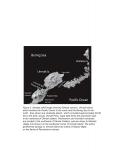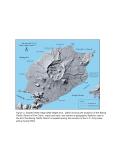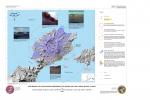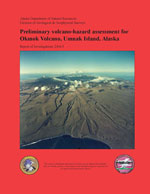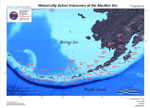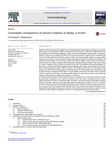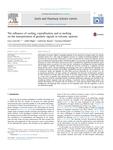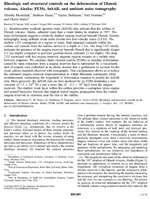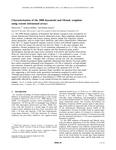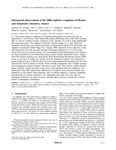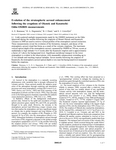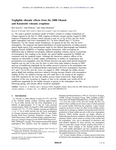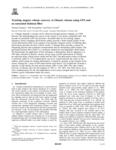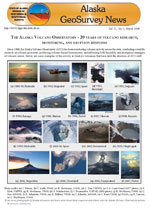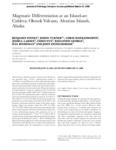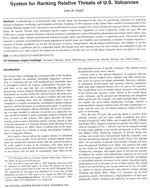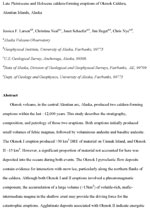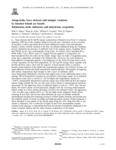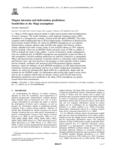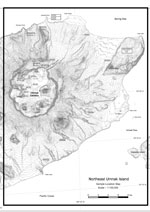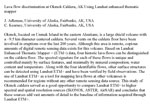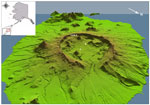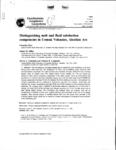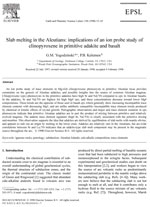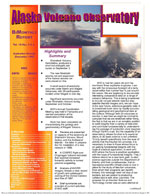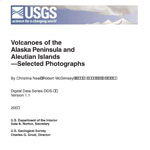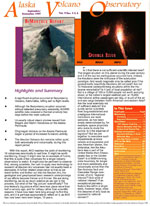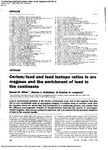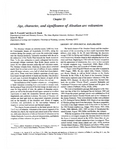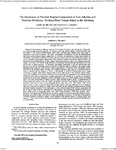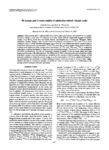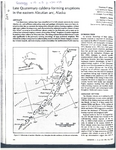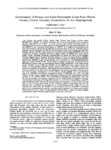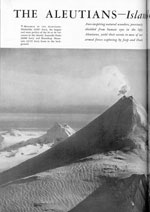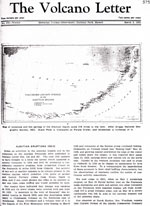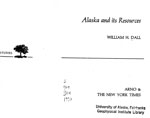References
McNutt, S.R., 2025, Long swarms and short swarms at volcanoes - evidence for different processes: Annals of Geophysics v. 68, no. 1, 16 p. https://doi.org/10.4401/ag-9156
Saunders-Schultz, P., Lopez, T., Dietterich, H., and Girona, T., 2024, Automatic identification and quantification of volcanic hotspots in Alaska using HotLINK - the hotspot learning and identification network: Frontiers in Earth Science v. 12, 1345104. https://doi.org/10.3389/feart.2024.1345104
Orr, T.R., Dietterich, H.R., Fee D., Girona, T., Grapenthin, R., Haney, M.M., Loewen, M.W., Lyons, J.J., Power, J.A., Schwaiger, H.F., Schneider, D.J., Tan, D., Toney, L., Wasser, V.K., and Waythomas, C.F., 2024, 2021 Volcanic activity in Alaska and the Commonwealth of the Northern Mariana Islands - Summary of events and response of the Alaska Volcano Observatory: U.S. Geological Survey Scientific Investigations Report 2024-5014, 64 p. https://doi.org/10.3133/sir20245014.
Kupres, C., 2024, Transient seismic velocities beneath active volcanoes: West Lafayette, Ind., Purdue University, M.S. thesis, 52 p.
Wang, J., 2024, Deformation mapping and modeling of the Aleutian volcanoes with InSAR and numerical models: University Park, Tex., Southern Methodist University, Ph.D. dissertation, 143 p.
Konstantinou, K.I., 2024, Dike volume derived from seismicity as a gauge of fracture toughness and propagation dynamics: Scientific Reports v. 14, 17593. https://doi.org/10.1038/s41598-024-67724-0
Sanders-Schultz, P., 2024, Deep learning detection and quantification of volcanic thermal signals in infrared satellite data: Fairbanks, Alaska, University of Alaska Fairbanks, M.S. thesis, 64 p.
Poland, M.P., 2024, Remote sensing of volcano deformation and surface change in Chaussard, E., and others, eds., Remote sensing for characterization of geohazards and natural resources: Cham, Switzerland, Springer, p. 173-203. https://doi.org/10.1007/978-3-031-59306-2_9
Coombs, M.L., Cameron, C.E., Dietterich, H.R., Boyce, E.S., Wech, A.G., Grapenthin, R., Wallace, K.L., Parker, T., Lopez, T., Crass, S., Fee, D., Haney, M.M., Ketner, D., Loewen, M.W., Lyons, J.J., Nakai, J.S., Power, J.A., Botnick, S., Brewster, I., Enders, M.L., Harmon, D., Kelly, P.J., and Randall, M., 2024, From field station to forecast: managing data at the Alaska Volcano Observatory: Bulletin of Volcanology v. 86, 79. https://doi.org/10.1007/s00445-024-01766-0
Bugisser, A., Peccia, A., Plank, T., and Moussallam, Y., 2024, Numerical simulations of the latest caldera-forming eruption of Okmok volcano, Alaska: Bulletin of Volcanology v. 86, 77. https://doi.org/10.1007/s00445-024-01765-1
Garza-Girón, R., Brodsky, E.E., Spica, Z.J., Haney, M.M., and Webley, P.W., 2023, A Specific Earthquake Processing Workflow for Studying Long-Lived, Explosive Volcanic Eruptions With Application to the 2008 Okmok Volcano, Alaska, Eruption: Journal of Geophysical Research: Solid Earth v. 128, no. 5, article no. e2022JB025882, 16 p. https://doi.org/10.1029/2022JB025882.
Cameron, C.E., Bull, K.F., and Macpherson, A.E., 2023, Recently active volcanoes of Alaska: Alaska Division of Geological & Geophysical Surveys Miscellaneous Publication 133 v. 6, 2 sheets. https://doi.org/10.14509/31086.
Peccia, A., Moussallam, Y., Plank, T., DallaSanta, K., Polvani, L., Burgisser, A., Larsen, J., and Schaefer, J., 2023, A new multi-method assessment of stratospheric sulfur load from the Okmok II caldera-forming eruption of 43 BCE: Geophysical Research Letters v. 50, no. 21, e2023GL103334. https://doi.org/10.1029/2023GL103334.
Lubbers, J., Loewen, M., Wallace, K., Coombs, M., and Addison, J., 2023, Probabilistic source classification of large tephra producing eruptions using supervised machine learning - an example from the Alaska-Aleutian Arc: Geochemistry, Geophysics, Geosystems v. 24, no. 11, e2023GC011037. https://doi.org/10.1029/2023GC011037.
Larsen, J.F., Neal, C.A., Schaefer, J.R., and Nye, C.J., 2023, Geologic map of Okmok Volcano: Alaska Division of Geological & Geophysical Surveys Report of Investigation 2023-1, 63 p., 4 sheets. https://doi.org/10.14509/31015
Garza-Girón, R., E.E. Brodsky, Z.J. Spica, M.M. Haney, P.W. Webley, 2023, Earthquakes record cycles of opening and closing in the enhanced seismic catalog of the 2008 Okmok Volcano, Alaska, eruption: Journal of Geophysical Research: Solid Earth v. 123, no. 7, e2023JB026893. https://doi.org/10.1029/2023JB026893
Wang, J., Lu, Z., Bekaert, D., Marshak, C., Govorcin, M., Sangha, S., Kennedy, J., and Gregg, P., 2023, Along-arc volcanism in the western and central Aleutian from 2015 to 2021 revealed by cloud-based InSAR processing: Geophysical Research Letters v. 50, no. 23, e2023GL106323. https://doi.org/10.1029/2023GL106323
Plunkett, G., Sigl, M., McConnell, J.R., Pilcher, J.R., and Chellman, N.J., 2023, The significance of volcanic ash in Greenland ice cores during the Common Era: Quaternary Science Reviews v. 301, 107936. https://doi.org/10.1016/j.quascirev.2022.107936
Hornby, A., Gazel, E., Bush, C., Dayton, K., and Mahowald, N., 2023, Phases in fine volcanic ash: Scientific Reports v. 13, 15728. https://doi.org/10.1038/s41598-023-41412-x
Alaska Volcano Observatory, National Oceanic and Atmospheric Administration, National Weather Service, Federal Aviation Administration, Department of Defense, United States Coast Guard, Division of Homeland Security and Emergency Management, Alaska Department of Environmental Conservation, and Alaska Department of Health and Social Services (participating agencies), 2022, Alaska interagency operating plan for volcanic ash episodes, 85 p.
Larsen, J.F., Schaefer, J.R., and Cameron, C.E., 2022, Electron probe microanalytical data of minerals and glass from rock samples from Okmok volcano, Alaska: Alaska Division of Geological & Geophysical Surveys Raw Data File 2022-6, 13 p. https://doi.org/10.14509/30853.
Cameron, C.E., Crass, S.W., and AVO Staff, eds, 2022, Geologic database of information on volcanoes in Alaska (GeoDIVA): Alaska Division of Geologic and Geophysical Surveys Digital Data Series 20, https://doi.org/10.14509/geodiva, https://doi.org/10.14509/30901.
Kasatkina, E., Koulakov, I., Grapenthin, R., Izbekov, P., Larsen, J. F., Al Arifi, N., and Saleh Ismail Qaysi, 2022, Multiple magma sources beneath the Okmok
caldera as inferred from local earthquake tomography: Journal of Geophysical Research: Solid Earth, v. 127. doi.org/10.1029/2022JB024656.
Reath, K., Pritchard, M.E., Roman, D.C., Lopez, T., Carn, S., Fischer, T.P., Lu, Z., Poland, M.P., Vaughan, R.G., Wessels, R., Wike, L.L., and Tran, H.K., 2021, Quantifying eruptive and background seismicity, deformation, degassing, and thermal emissions at volcanoes in the United States during 1978-2020: Journal of Geophysical Research: Solid Earth, v. 126, e2021JB021684, doi: 10.1029/2021JB021684.
Bennington, N.L., Ohlendorf, S.J., Thurber, C.H., and Haney, M.M., 2021, Spatiotemporal analysis of seismic velocity changes at Okmok volcano, Alaska and implications from deformation source modeling: Earth and Planetary Science Letters, v. 561, p. 1-11.
Manta, Fabio, Occhipinti, Giovanni, Hill, E.M., Perttu, Anna, Assink, Jelle, and Taisne, Benoit, 2021, Correlation between GNSS-TEC and eruption magnitude supports the use of ionospheric sensing to complement volcanic hazard assessment: Journal of Geophysical Research: Solid Earth, v. 126, no. 2, p. 1-17. doi.org/10.1029/2020JB020726.
Wang Jiahui, Lu Zhong, and Gregg, P.M., 2021, Inflation of Okmok Volcano during 2008-2020 from PS analyses and source inversion with finite element models: Journal of Geophysical Research: Solid Earth, v. 126, no. 10, p.17.
Jin-Ting Kang, Yu-Han Qi, Kan Li, Jiang-Hao Bai, Hui-Min Yu, Wang Zheng, Zhao-Feng Zhang, and Fang Huang, 2021, Calcium isotope compositions of arc magmas: Implications for Ca and carbonate recycling in subduction zones: Geochimica et Cosmochimica Acta, v. 306, p. 1-19.
Power, J.A., Haney, M.M., Botnick, S.M., Dixon, J.P., Fee, David, Kaufman, A.M., Ketner, D.M., Lyons, J.J., Parker, Tom, Paskievitch, J.F., Read, C.W., Searcy, Cheryl, Stihler, S.D., Tepp, Gabrielle, and Wech, A.G., 2020, Goals and development of the Alaska Volcano Observatory seismic network and application to forecasting and detecting volcanic eruptions: Seismological Research Letters, doi: 10.1785/0220190216 .
Cameron, C.E., Schaefer, J.R., and Ekberg, P.G., 2020, Historically active volcanoes of Alaska: Alaska Division of Geological & Geophysical Surveys Miscellaneous Publication 133 v. 4, 2 sheets. Http://doi.org/10.14509/30426
Bergfeld, Deborah, Evans, W.C., Hunt, A.G., Lopez, Taryn, and Schaefer, J.R., 2020, A post-eruption study of gases and thermal waters at Okmok volcano, Alaska: Journal of Volcanology and Geothermal Research, v, 396, doi:10.1016/j.jvolgeores.2020.106853.
Sanderson, R.W., Matoza, R.S., Fee, David, Haney, M.M., and Lyons, J.J., 2020, Remote detection and location of explosive volcanism in Alaska with the EarthScope Transportable Array: Journal of Geophysical Research: Solid Earth, v. 125, 23 p., doi: https://doi.org/10.1029/2019JB018347
Dai, Chunli, Howat, I.M., Freymueller, J.T., Vijay, Saurabh, and Jia, Yuanyuan, 2020, Characterization of the 2008 phreatomagmatic eruption of Okmok from ArcticDEM and InSAR: Deposition, erosion, and deformation: Journal of Geophysical Research, v. 125, 15 p., https://doi.
Org/10.1029/2019JB018977
McConnell, J.R., Sigl, Michael, Plunkett, Gil, Burke, Andrea, Kim, W.M., Raible, C.C., Wilson, A.I., Manning, J.G., Ludlow, Francis, Chellman, N.J., Innes, H.M., Yang, Zhen, Larsen, J.F., Schaefer, J.R., Kipfstuhl, Sepp, Mojtabavi, Seyedhamidreza, Wilhelms, Frank, Opel, Thomas, Meyer, Hanno, and Steffensen, J.P., 2020, Extreme climate after massive eruption of Alaska's Okmok volcano in 43 BCE and effects on the late Roman Republic and Ptolemaic Kingdom: Proceedings of the National Academy of Science of the United States of America, 7 p., www.pnas.org/cgi/doi/10.1073/pnas.2002722117.
Plank, T., Rasmussen, D., Stelling, P., and Roman, D., 2020, Field report for the collection of mafic tephra from the Aleutian Islands between Unimak and the Islands of Four Mountains (Alaska, USA), version 1.0: Interdisciplinary Earth Data Alliance (IEDA), https://doi.org/10.26022/IEDA/111584. Accessed 2020-06-25.
Cameron, C.E., Dixon, J.P., Waythomas, C.F., Iezzi, A.M., Wallace, K.L., McGimsey, R.G., and Bull, K.F., 2020, 2016 Volcanic activity in Alaska-Summary of events and response of the Alaska Volcano Observatory: U.S. Geological Survey Scientific Investigations Report 2020-5125, 63 p., https://doi.org/10.3133/sir20205125.
Dixon, J.P., Cameron, C.E., Iezzi, A.M., Power, J.A., Wallace, K., and Waythomas, C.F., 2020, 2017 Volcanic activity in Alaska-Summary of events and response of the Alaska Volcano Observatory: U.S. Geological Survey Scientific Investigations Report 2020-5102, 61 p., https://doi.org/10.3133/sir20205102.
Lerner, A.H., O'Hara, D., Karlstrom, L., Ebmeier, S.K., Anderson, K.R., and Hurwitz, S., 2020, The prevalence and significance of offset magma reservoirs at arc volcanoes: Geophysical Research Letters, v. 47, doi:10.1029/2020GL087856.
Lerner, A.H., 2020, The depths and locations of magma reservoirs and their consequences for the behavior of sulfur and volcanic degassing: University of Oregon Ph.D. thesis, 378 p. Available at https://search.proquest.com/openview/cec1ff16af338dce2495b5a1a491aa88/1?pq-origsite=gscholar&cbl=44156.
Miller, D.J., Bennington, Ninfa, Haney, M.M., Bedrosian, Paul, Key, Kerry, Thurber, Clifford, Hart, Laney, and Ohlendorf, Summer, 2020, Linking magma storage and ascent to eruption volume and composition at an arc caldera: Geophysical Research Letters, v. 47, article no. e2020GL088122, 9 p., http://dx.doi.org/10.1029/2020GL088122.
Woods, T.W., Genareau, K., and Wallace, K.L., 2020, Influence of grain size and shape on volcanic ash electrical conductivity: Journal of Volcanology and Geothermal Research, v. 393, no. 106788, 9 p., doi: 10.1016/j.jvolgeores.2020.106788.
Xue Xueming, Freymueller, J.T., and Lu Zhong, 2020, Modeling the posteruptive deformation at Okmok based on the GPS and InSAR time series: Changes in the shallow magma storage system: Journal of Geophysical Research: Solid Earth, v. 125, no. 2, p. 1-29. http://dx.doi.org/10.1029/2019JB017801.
DeGrandpre, Kimberly, 2020, Characterization of magma storage and dynamics at Akutan, Semisopochnoi, and Okmok volcanoes from analytical and numerical models of geodetic, seismic and petrologic data: Dallas, Southern Methodist University, PhD. dissertation, 556 p., 158 figs.
Oppenheimer, C., 2020, The sun of Rome is set! Volcanic dust veils and their political fallout: PNAS v. 117, no. 30, p. 17470-17472. https://doi.org/10.1073/pnas.2011054117
Plank, T., Rasmussen, D. J., Stelling, P., and Roman, D. C., 2020, Field report for the collection of mafic tephra from the Aleutians Islands between Unimak and the Island of Four Mountains (Alaska, USA), version 1.0: Interdisciplinary Earth Data Alliance (IEDA). https://doi.org/10.26022/IEDA/111584
Walwer, D., Ghil, M., and Calais, E., 2019, Oscillatory nature of the Okmok volcano's deformation: Earth and Planetary Science Letters, v. 506, p. 76-86, doi: 10.1016/j.epsl.2018.10.033
Schwaiger, H.F., Iezzi, A.M., and Fee, David, 2019, AVO-G2S: A modified, open-source Ground-to-Space atmospheric specification for infrasound modeling: Computers and Geosciences, v. 125, p. 90-97, doi:10.1016/j.cageo.2018.12.013.
Dixon, J.P., Stihler S.D., Haney, M.M., Lyons, J.J., Ketner, D.M., Mulliken, K.M., Parker, T., and Power, J.A., 2019, Catalog of earthquake parameters and description of seismograph and infrasound stations at Alaskan volcanoes - January 1, 2013, through December 31, 2017: U.S. Geological Survey Data Series 1115, 92 p., https://doi.org/10.3133/ds1115.
Albright, J. A., Gregg, P. M., Lu, Z., and Freymueller, J. T., 2019, Hindcasting
magma reservoir stability preceding the 2008 eruption of Okmok, Alaska:
Geophysical Research Letters, v. 46. https://doi.org/10.1029/2019GL083395
Power, J.A., Friberg, P.A., Haney, M.M., Parker, T., Stihler, S.D., and Dixon, J.P., 2019, A unified catalog of earthquake hypocenters and magnitudes at volcanoes in Alaska—1989 to 2018: U.S. Geological Survey Scientific Investigations Report 2019–5037, 17 p., https://doi.org/10.3133/sir20195037.
Westberry, T.K., Shi, Y.R., Yu, H., Behrenfeld, M.J., and Remer, L.A., 2019, Satellite-detected ocean ecosystem response to volcanic eruptions in the subarctic Northeast Pacific Ocean: Geophysical Research Letters, v. 6, n. 20, p. 11270-11280, doi: http://dx.doi.org/10.1029/2019GL083977.
Rasmussen, D.J., and Plank, T.A., 2019, Bulk rock data for the central-eastern Aleutian volcanoes, version 1.0: Interdisciplinary Earth Data Alliance (IEDA). https://doi.org/10.26022/IEDA/111870
Nye, C.J., Beget, J.E., Layer, P.W., Mangan, M.T., McConnell, V.S., McGimsey, R.G., Miller, T.P., Moore, R.B., and Stelling, P.L., 2018, Geochemistry of some quaternary lavas from the Aleutian Arc and Mt. Wrangell: Alaska Division of Geological & Geophysical Surveys Raw Data File 2018-1, 29 p. http://doi.org/10.14509/29843
Mulliken, K.M., Schaefer, J.R., and Cameron, C.E., 2018, Geospatial distribution of tephra fall in Alaska: a geodatabase compilation of published tephra fall occurrences from the Pleistocene to the present: Alaska Division of Geological & Geophysical Surveys Miscellaneous Publication 164, 46 p. http://doi.org/10.14509/29847
Mulliken, K.M., 2018, The Alaska Volcano Observatory: 30 years of protecting Alaskans from the effects of volcanic activity (1988-2018): Alaska Division of Geological & Geophysical Surveys Information Circular 67, 2 p. http://doi.org/10.14509/30032
Pesicek, J.D., Wellik, J.J., Prejean, S.G., and Ogburn, S.E., 2018, Prevalence of seismic rate anomalies preceding volcanic eruptions in Alaska: Frontiers in Earth Science, v. 6, article 100, doi: 10.3389/feart.2018.00100 .
Roman, D.C., and Cashman, K.V., 2018, Top-down precursory volcanic seismicity: implications for 'stealth' mamga ascent and long-term eruption forecasting: Frontiers in Earth Science, v. 6, article 124, doi: 10.3389/feart.2018.00124 .
Prejean, S.G., and Hill, D.P., 2018, The influence of tectonic environment on dynamic earthquake triggering: a review and case study on Alaskan volcanoes: Tectonophysics, v. 745, p. 293-304, doi.org/10.1016/j.tecto.2018.08.007.
Worden, A.K., Schaefer, J.R., and Mulliken, K.M., 2018, Tephra occurrence in Alaska: a map-based compilation of stratigraphic tephra data: Alaska Division of Geological and Geophysical Surveys Miscellaneous Publication 165, 19 p., http://doi.org/10.14509/30059
Ewert, J.W., Diefenbach, A.K., and Ramsey, D.W., 2018, 2018 update to the U.S. Geological Survey national volcanic threat assessment: U.S. Geological Survey Scientific Investigations Report 2018-5140, 40 p., https://pubs.usgs.gov/sir/2018/5140/sir20185140.pdf.
Derkachev, A.N., Ponomareva, V.V., Portnyagin, M.V., Gorbarenko, S.A., Nikolaeva, N.A., Malakhov, M.I., Zelenin, E.A., Nurnberg, D., and Liu, Yanguang, 2018, Widespread tephra layers in the Bering Sea sediments: distal clues to large explosive eruptions from the Aleutian volcanic arc: Bulletin of Volcanology, 17 p., v. 80, n. 80, doi: 0.1007/s00445-018-1254-9
Albino, F., Amelung, F., and Gregg, P., 2018, The role of pore fluid pressure on the failure of magma reservoirs: insights from Indonesian and Aleutian Arc volcanoes: Journal of Geophysical Research, v. 123, n.2, p. 1328-1349, doi: 10.1002/2017JB014523
Cameron, C.E., Schaefer, J.R., and Mulliken, K.M., 2018, Historically active volcanoes of Alaska: Alaska Division of Geological & Geophysical Surveys Miscellaneous Publication 133 v. 3, 2 sheets. Http://doi.org/10.14509/30142
Hart, Laney, 2018, Earthquake detection, relocation, and body-wave tomography at Okmok Volcano, Alaska: University of Wisconsin at Madison, Madison, Wisconsin, Masters thesis.
Miller, D.J., 2018, Ambient noise tomography of Okmok Caldera, Alaska: University of Wisconsin at Madison Masters thesis.
Reinisch, E. C., Cardiff, M., and Feigl, K. L., 2017, Graph theory for analyzing pair-wise data: application to geophysical model parameters estimated from interferometric synthetic aperture radar data at Okmok volcano, Alaska: Journal of Geodesy, v. 91, n. 1, p. 9-24.
Unglert, K., and Jellinek, A.M., 2017, Feasibility study of spectral pattern recognition reveals distinct classes of volcanic tremor: Journal of Volcanology and Geothermal Research, v. 336, p. 219-244.
Cameron, C.E., Dixon, J.P., Neal, C.A., Waythomas, C.F., Schaefer, J.R., and McGimsey, R.G., 2017, 2014 Volcanic activity in Alaska - Summary of events and response of the Alaska Volcano Observatory: U.S. Geological Survey Scientific Investigations Report 2017-5077, 81 p., https://doi.org/10.3133/sir20175077.
Okuno, Mitsuru, Izbekov, Pavel, Nicolaysen, K.P., Sato, Eiichi, Nakamura, Toshio, Savinetsky, A.B., Vasyukov, Dmitrii, Krylovich, O.A., Khasanov, Bulat, Miranda, Jonathan, Persico, Lyman, Hatfield, Virginia, West, D.L., and Bruner, K.M., 2017, AMS radiocarbon dates on peat section related with tephra and archaeological sites in Carlisle Island, the Islands of Four Mountains, Alaska: Radiocarbon, v. 59, no. 6, p. 1771-1778.
Unema, J.A., Ort, M.H., Larsen, J.F., Neal, C.A., and Schaefer, J.R., 2016, Water-magma interaction and plume processes in the 2008 Okmok eruption, Alaska: GSA Bulletin, 15 p., doi:10.1130/B31360.1
Cameron, C.E., and Schaefer, J.R., 2016, Historically active volcanoes of Alaska: Alaska Division of Geological & Geophysical Surveys Miscellaneous Publication 133 v. 2, 1 sheet, scale 1:3,000,000. http://doi.org/10.14509/20181
Masterlark, T., Donovan, T., Feigl, K. L., Haney, M., Thurber, C. H., and Tung, S., 2016, Volcano deformation source parameters estimated from InSAR: Sensitivities to uncertainties in seismic tomography: Journal of Geophysical Research: Solid Earth, v. 121, n. 4, p. 3002-3016.
Pouget, S., Bursik, M., Johnson, C.G., Hogg, A.J., Phillips, J.C., and Sparks, R.S.J., 2016, Interpretation of umbrella cloud growth and morphology; implications for flow regimes of short-lived and long-lived eruptions: Bulletin of Volcanology v. 78, n. 1, article 1, 19 p.
Cameron, C.E., and Snedigar, S.F., 2016, Alaska Volcano Observatory image database: Alaska Division of Geological & Geophysical Surveys Digital Data Series 13, https://www.avo.alaska.edu/images/. https://doi.org/10.14509/29689.
Larsen, J.F., Neal, C.A., Schaefer, J.R., Kaufman, A.M., and Lu, Zhong, 2015, The 2008 phreatomagmatic eruption of Okmok Volcano, Aleutian Islands, Alaska: Chronology, deposits, and landform changes: Alaska Division of Geological & Geophysical Surveys Report of Investigation 2015-2, 53 p. doi:10.14509/29405
Waythomas, C.F., 2015, Geomorphic consequences of volcanic eruptions in Alaska: A review: Geomorphology, v. 246, p. 123-145, doi: 10.1016/j.geomorph.2015.06.004
Evans, W.C., Bergfeld, D., Neal, C.A., McGimsey, R.G., Werner, C.A., Waythomas, C.F., Lewicki, J.L., Lopez, T., Mangan, M.T., Miller, T.P., Diefenbach, A., Schaefer, J., Coombs, M.L., Wang, B., Nicolaysen, K., Izbekov, P., Maharrey, Z., Huebner, M., Hunt, A.G., Fitzpatrick, J., and Freeburg, G., 2015, Aleutian Arc geothermal fluids: chemical analyses of waters and gases: U.S. Geological Survey Data release, http://dx.doi.org/10.5066/F74X55VB
Dixon, J.P., Cameron, Cheryl, McGimsey, R.G., Neal, C.A., and Waythomas, Chris, 2015, 2013 Volcanic activity in Alaska - Summary of events and response of the Alaska Volcano Observatory: U.S. Geological Survey Scientific Investigations Report 2015-5110, 92 p., http://dx.doi.org/10.3133/sir20155110.
Qu, Feifei, Lu, Zhong, Poland, Michael, Freymuller, Jeffrey, Zhang, Qin, and Jung, Hyung-Sup, 2015, Post-eruptive inflation of Okmok Volcano, Alaska, from InSAR, 2008-2014: Remote Sensing, v. 7, p. 16778-16794
Doi:10.3390/rs71215839 .
Reyes, C.G., 2015, Deciphering Okmok Volcano's restless years (2002-2005): University of Alaska Fairbanks Ph.D. dissertation, 82 p., available at https://scholarworks.alaska.edu/handle/11122/6120?show=full .
Bennington, N.L., Haney, Matthew, De Angelis, Silvio, Thurber, C.H., and Freymueller, Jeffrey, 2015, Monitoring changes in seismic velocity related to an ongoing rapid inflation event at Okmok volcano, Alaska: Journal of Geophysical Research Solid Earth, v. 120, p. 5664-5676, doi:10.1002/2015JB01
Ball, J. G. C., Reed, B. E., Grainger, R. G., Peters, D. M., Mather, T. A., and Pyle, D. M., 2015, Measurements of the complex refractive index of volcanic ash at 450, 546.7, and 650 nm: Journal of Geophysical Research: Atmospheres, v. 120, n. 15, p. 7747-7757.
Schaefer, J.R., Cameron, C.E., and Nye, C.J., 2014, Historically active volcanoes of Alaska: Alaska Division of Geological & Geophysical Surveys Miscellaneous Publication 133 v. 1.2, 1 sheet, scale 1:3,000,000.
This publication has been superseded. Newest version available at http://www.dggs.alaska.gov/pubs/id/20181 .
Buurman, Helena, Nye, C.J., West, M.E., and Cameron, Cheryl, 2014, Regional controls on volcano seismicity along the Aleutian Arc: Geochemistry, Geophysics, Geosystems, doi:10.1002/2013GC005101
Ohlendorf, S.J., Thurber, C.H., Pesicek, J.D., and Prejean, S.G., 2014, Seismicity and seismic structure at Okmok Volcano, Alaska: Journal of Volcanology and Geothermal Research, v. 278-279, p. 103-119, doi:10.1016/j.jvolgeores.2014.04.002
Cameron, C.E., and Nye, C.J., 2014, Preliminary database of Quaternary vents in Alaska: Alaska Division of Geological & Geophysical Surveys Miscellaneous Publication 153, 11 p., doi:10.14509/27357 .
McGimsey, R.G., Maharrey, J.Z., and Neal, C.A., 2014, 2011 Volcanic activity in Alaska: Summary of events and response of the Alaska Volcano Observatory: U.S. Geological Survey Scientific Investigations Report 2014-5159, 50 p., http://dx.doi.org/10.3133/sir20145159.
Haney, M.M., 2014, Backprojection of volcanic tremor: Geophysical Research Letters, v. 41, p. 1923-1928, doi:10.1002/2013GL058836
Lu, Zhong, and Dzurisin, Daniel, 2014, InSAR imaging of Aleutian volcanoes: Chichester, UK, Springer-Praxis, 390 p.
Caricchi, Luca, Biggs, Juliet, Annen, Catherine, and Ebmeier, Susanna, 2014, The influence of cooling, crystallization and re-melting on the interpretation of geodetic signals in volcanic systems: Earth and Planetary Science Letters, v. 388, p. 166-174, http://dx.doi.org/10.1016/j.epsl.2013.12.002
Miller, S. A., 2014, Post eruptive source modeling for Okmok Volcano, Alaska using GPS and InSAR: University of Alaska Fairbanks M.S. thesis, 92 p.
Guffanti, Marianne, and Miller, Tom, 2013, A volcanic activity alert-level system for aviation: review of its development and application in Alaska: Natural Hazards, 15 p., doi:0.1007/s11069-013-0761-4
Dixon, J.P., Stihler, S.D, Power, J.A., Haney, Matt, Parker, Tom, Searcy, C.K., and Prejean, Stephanie, 2013, Catalog of earthquake hypocenters at Alaskan volcanoes: January 1 through December 31, 2012: U.S. Geological Survey Data Series 789, 84 p., available at http://pubs.usgs.gov/ds/789/ .
Larsen, J.F., Sliwinski, M.G., Nye, Christopher, Cameron, Cheryl, and Schaefer, J.R., 2013, The 2008 eruption of Okmok Volcano, Alaska: Petrological and geochemical constraints on the subsurface magma plumbing system: Journal of Volcanology and Geothermal Research, v. 264, p. 85-106, doi:10.1016/j.jvolgeores.2013.07.003 .
Pouget, Solene, Bursik, Marcus, Webley, Peter, Dehn, Jon, and Pavolonis, Michael, 2013, Estimation of eruption source parameters from umbrella cloud or downwind plume growth rate: Journal of Volcanology and Geothermal Research, v. 258, p. 100-112, http://dx.doi.org/10.1016/j.jvolgeores.2013.04.002
Prejean, Stephanie, Moran, Seth, and Power, John, 2012, Volcanic earthquakes in Alaska's National Parks: in Winfree, Robert (project lead), Katmai Science Studies: Alaska Park Science Journal, v. 11, n. 1, p. 40-45, available online at http://www.nps.gov/akso/nature/science/ak_park_science/volume_11_issue_1.cfm .
Hard Copy held by AVO at FBKS - CEC shelf
Dixon, J.P., Stihler, S.D., Power, J.A., and Searcy, C.K., 2012, Catalog of earthquake hypocenters at Alaskan volcanoes: January 1 through December 31, 2011: U.S. Geological Survey Data Series 730, 82 p., available online at http://pubs.usgs.gov/ds/730/pdf/ds730.pdf .
Ruppert, N.A., Kozyreva, N.P., and Hansen, R.A., 2012, Review of crustal seismicity in the Aleutian Arc and implications for arc deformation: Tectonophysics, v. 522-523, p. 150-157, doi:10.1016/j.tecto.2011.11.024 .
Larsen, J.F., Schaefer, J.R., and Neal, C.A., 2012, Written communication.
Masterlark, Timothy, Feigl, K.L., Haney, Matthew, Stone, Jonathan, Thurber, Clifford, and Ronchin, Erika, 2012, Nonlinear estimation of geometric parameters in FEMs of volcano deformation: Integrating tomography models and geodetic data for Okmok volcano, Alaska: Journal of Geophysical Research, v. 117, B02407, 17p., doi:10.1029/2011JB008811 .
Pesicek, J.D., Sileny, J., Prejean, S.G., and Thurber, C.H., 2012, Determination and uncertainty of moment tensors for microearthquakes at Okmok Volcano, Alaska: Geophysical Journal International, v. 190, p. 1689-1709.
Neal, C.A., McGimsey, R.G., Dixon, J.P., Cameron, C.E., Nuzhaev, A.A., and Chibisova, Marina, 2011, 2008 Volcanic activity in Alaska, Kamchatka, and the Kurile Islands: Summary of events and response of the Alaska Volcano Observatory: U.S. Geological Survey Scientific Investigations Report 2010-5243, 94 p., available at http://pubs.usgs.gov/sir/2010/5243 .
Oppenheimer, Clive, 2011, Eruptions that shook the world: New York, Cambridge University Press, 392 p.
Weaver, S.L., Wallace, P.L., and Johnston, A.D., 2011, A comparative study of continental vs. intraoceanic arc mantle melting: experimentally determined phase relations of hydrous primitive melts: Earth and Planetary Science Letters, v. 308, n. 1-2, p. 97-106, doi:10.1016/j.epsl.2011.05.040 .
Dabrowa, A.L., Green, D.N., Rust, A.C., and Phillips, J.C., 2011, A global study of volcanic infrasound characteristics and the potential for long-range monitoring: Earth and Planetary Science Letters, v. 310, p. 369-379, doi:10.1016/j.epsl.2011.08.027.
Dixon, J.P., Stihler, S.D., Power, J.A., and Searcy, C.K., 2011, Catalog of earthquake hypocenters at Alaskan volcanoes: January 1 through December 31, 2010: U.S. Geological Survey Data Series 645, 82 p., available online at http://pubs.usgs.gov/ds/645/
Schaefer, J.R., Larsen, J.F., and Unema, J.A., 2011, Digital elevation model (DEM) and shaded relief image of Okmok Caldera, 2010: Alaska Division of Geological & Geophysical Surveys Raw Data File 2011-6, 1 DVD, available online at http://www.dggs.dnr.state.ak.us/pubs/id/23223 .
De Angelis, S., McNutt, S.R., and Webley, P.W., 2011, Evidence of atmospheric gravity waves during the 2008 eruption of Okmok volcano from seismic and remote sensing observations: Geophysical Research Letters, v. 38, L10303, doi:10.1029/2011GL047144, 6 p.
Peterson, C.L., McNutt, S.R., and Christensen, D.H., Nonvolcanic tremor in the Aleutian Arc: Bulletin of the Seismological Society of America, v. 101, n. 6, p. 3081-3087, doi:10.1785/?0120100241 .
Wong, L.J., and Larsen, J.F., 2010, The Middle Scoria sequence: A Holocene violent strombolian, subplinian, and phreatomagmatic eruption of Okmok volcano, Alaska: Bulletin of Volcanology, v. 72, p. 17-31.
Hard Copy held by AVO at FBKS - CEC shelf
Masterlark, T, M. Haney, H. Dickinson, T. Fournier and C. Searcy (2010), Rheologic and structural controls on the deformation of Okmok Volcano, Alaska: FEM's, InSAR, and ambient noise tomography: Journal of Geophysical Research v. 115, n. B02409, doi:10.1029/2009JB006324.
Lu, Zhong, and Dzurisin, Daniel, 2010, Ground surface deformation patterns, magma supply, and magma storage at Okmok volcano, Alaska, inferred from InSAR analysis: 2. Co-eruptive deflation, July-August 2008: Journal of Geophysical Research, v. 115, n. B00B03, 13 p., doi:10.1029/2009JB006970 .
Lu, Zhong, Dzurisin, Daniel, Biggs, Juliet, Wichs, Charles Jr., and McNutt, Steve, 2010, Ground surface deformation patterns, magma supply, and magma storage at Okmok volcano, Alaska, from InSAR analysis: 1. Intereruption deformation, 1997-2008: Journal of Geophysical Research, v. 115, n. B00B02, 14 p., doi:10.1029/2009JB006969 .
Dixon, J.P., Stihler, S.D., Power, J.A., and Searcy, C.K., 2010, Catalog of earthquake hypocenters at Alaskan volcanoes: January 1 through December 31, 2009: U.S. Geological Survey Data Series 531, 84 p., available online at http://pubs.usgs.gov/ds/531/ .
Fee, David, Steffke, Andrea, and Garces, Milton, 2010, Characterization of the 2008 Kasatochi and Okmok eruptions using remote infrasound arrays: Journal of Geophysical Research, v. 115, n. D00L10, 15 p., doi:10.1029/2009JD013621 .
Arnoult, K.M., Olson, J.V., Szuberla, C.A.L., McNutt, S.R., Garces, M.A., Fee, David, and Hedlin, M.A.H., 2010, Infrasound observations of the 2008 explosive eruptions of Okmok and Kasatochi volcanoes, Alaska: Journal of Geophysical Research, v. 115, n. D00L14, 12 p.,
doi: 10.1029/2010JD013987 .
Haney, M.M., 2010, Location and mechanism of very long period tremor during the 2008 eruption of Okmok Volcano from interstation arrival times: Journal of Geophysical Research, v. 115, n. B00B05, 13 p.,
doi: 10.1029/2010JB007440 .
Yogodzinski, G.M., Vervoort, J.D., Brown, S.T., and Gerseny, M., 2010. Subduction controls of Hf and Nd isotopes in lavas of the Aleutian island arc: Earth and Planetary Science Letters, v. 300, p. 226-238, doi: 10.1016/j.epsl.2010.09.035 .
Biggs, Juliet, Lu, Zhong, Fournier, Tom, and Freymueller, J.T., 2010, Magma flux at Okmok Volcano, Alaska, from a joint inversion of continuous GPS, campaign GPS, and interferometric synthetic aperture radar: Journal of Geophysical Research, v. 115, n. B12401, 11 p., doi: 10.1029/2010JB007577, 2010 .
Guffanti, Marianne, Casadevall, T.J., and Budding, Karin, 2010, Encounters of aircraft with volcanic ash clouds: A compilation of known incidents, 1953-2009: U.S. Geological Data Series 545, ver. 1.0, 12 p., plus 4 appendixes including the compliation database, available only at http://pubs.usgs.gov/ds/545 .
Freymueller, J.T., and Kaufman, A.M., 2010, Changes in the magma system during the 2008 eruption of Okmok volcano, Alaska, based on GPS measurements: Journal of Geophysical Research, v. 115, B12415, 14 p., doi: 10.1029/2010JB007716 .
Bourassa, A.E., Degenstein, D.A., Elash, B.J., and Llewellyn, E.J., 2010, Evolution of the stratospheric aerosol enhancement following the eruptions of Okmok and Kasatochi: Odin-OSIRIS measurements: Journal of Geophysical Research, v. 115, n. D00L03, 7 p., doi:10.1029/2009JD013274 .
D'Amours, Real, Malo, Alain, Servranckx, Rene, Bensimon, Dov, Trudel, Serge, and Gauthier-Bilodeau, Jean-Phillipe, 2010, Application of the atmospheric Lagrangian particle dispersion model MLDP0 to the 2008 eruption of Okmok and Kasatochi volcanoes: Journal of Geophysical Research, v. 115, n. D00L11, 11p., doi: 10.1029/2009JD013602.
Johnson, J.H., Prejean, Stephanie, Savage, M.K., and Townend, John, 2010, Anisotropy, repeating earthquakes, and seismicity associated with the 2008 eruption of Okmok volcano, Alaska: Journal of Geophysical Research, v. 115, n. B00B04, 21 p., doi:10.1029/2009JB006991 .
Mattis, Ina, Seifert, Patric, Muller, Detlef, Tesche, Matthias, Hiebsch, Anja, Kanitz, Thomas, Schmidt, Jorg, Finger, Fanny, Wandinger, Ulla, and Ansmann, Albert, 2010, Volcanic aerosol layers observed with multiwavelength Raman lidar over central Europe in 2008-2009: Journal of Geophysical Research, v. 115, n. D00L04, 9 p., doi:10.1029/2009JD013472 .
Spinei, Elena, Carn, S.A., Krotkov, N.A., Mount, G.H., Yang, Kai, and Krueger, Arlin, 2010, Validation of ozone monitoring instrument SO2 measurements in the Okmok volcanic cloud over Pullman, WA, July 2008: Journal of Geophysical Research, v. 115, n. D00L08, 14 p., doi:10.1029/2009JD013492 .
Kravitz, Ben, Robock, Alan, and Bourassa, Adam, 2010, Negligible climatic effects from the 2008 Okmok and Kasatochi volcanic eruptions: Journal of Geophysical Research, v. 115, n. D00L05, 16p., doi:10.1029/2009JD013525 .
Prata, A.J., Gangale, G., Clarisse, L., and Karagulian, F., 2010, Ash and sulfur dioxide in the 2008 eruptions of Okmok and Kasatochi: Insights from high spectral resolution satellite measurements: Journal of Geophysical Research, v. 115, n. D00L18, 18 p., doi:10.1029/2009JD013556 .
Schmale, J., Schneider, J., Jurkat, T., Voigt, C., Kalesse, H., Rautenhaus, M., Lichtenstern, M., Schlager, H., Ancellet, G., Arnold, F., Gerding, M., Mattis, I., Wendisch, M., and Borrmann, S., 2010, Aerosol layers from the 2008 eruptions of Mount Okmok and Mount Kasatochi: In situ upper troposphere and lower stratosphere measurements of sulfate and organics over Europe: Journal of Geophysical Research, v. 115, n. D00L07, 18 p., doi:10.1029/2009JD013628 .
Zimmer, M.M., Plank, Terry, Hauri, E.H., Yogodzinski, G.M., Stelling, Peter, Larsen, Jessica, Singer, Brad, Jicha, Brian, Mandeville, Charles, and Nye, C.J., 2010, The role of water in generating the calc-alkaline trend: new volatile data for Aleutian magmas and a new tholeiitic index: Journal of Petrology, v. 5, n. 12, p. 2411, 2444, doi:10.1093/petrology/egq062 .
McCarthy, E.B., 2010, Quantifcation of volcanogenic water vapor using the atmospheric infrared sounder (AIRS): Michigan Technological University Ph.D. dissertation, 170 p.
Langmann, B., Zaksek, K., Hort, M., and Duggen, S., 2010, Volcanic ash as fertiliser for the surface ocean: Atmospheric Chemistry and Physics, v. 10, n. 8, p. 3891-3899, open access available at http://www.atmos-chem-phys.net/10/3891/2010/acp-10-3891-2010.pdf .
Haney, M.M., 2010, Volcano monitoring with continuous seismic correlations: examples using ambient noise and volcanic tremor [abs.]: Seismological Research Letters, v. 81, n. 2, p. 351.
Manville, V., 2010, An overview of break-out floods from intracaldera lakes: Global and Planetary Change, v. 70, p. 14-23, doi:10.1016/j.gloplacha.2009.11.004.
University of Alaska Fairbanks Geophysical Institute, 2010, Geophysical Institute, 2007-2010 report: 48 p., available online at http://www.gi.alaska.edu/admin/info/gireport
McCarthy, E.B., 2010, Quantifications of volcanogenic water vapor using the atmospheric infrared sounder (AIRS): Michigan Techological University Ph.D. dissertation, 170 p.
Kufner, Sofia-Katerina, Savage, Martha, and Johnson, Jessica, 2010, Temporal variation of seismic anisotropy at Okmok Volcano (Alaska) [abs.]: Geological Society of New Zealand Miscellanous Publication, v. 291A, p. 161.
Neal, C.A., Larsen, J.F., and Schaefer, Janet, 2009, The July-August 2008 hydrovolcanic eruption of Okmok Volcano, Umnak Island, Alaska: Alaska Geological Society Newsletter, v. 39, n. 5, p. 1-3.
Fournier, Tom, Freymueller, Jeff, and Cervelli, Peter, 2009, Tracking magma volume recovery at Okmok volcano using GPS and an unscented Kalman filter: Journal of Geophysical Research, v. 114, B02405, 18 p., doi:10.1029/2008JB005837 .
Larsen, J., Neal, C., Webley, P., Freymueller, J., Haney, M., McNutt, S., Schneider, D., Prejean, S., Schaefer, J., and Wessels, R., 2009, Eruption of Alaska volcano breaks historic pattern: Eos, Transactions, American Geophysical Union, v. 90, n. 20, p. 173-174.
Dixon, J.P., and Stihler, S.D., 2009, Catalog of earthquake hypocenters at Alaskan volcanoes: January 1 through December 31, 2008: U.S. Geological Survey Data Series 467, 88 p., available at http://pubs.usgs.gov/ds/467/ .
Webley, P.W., Dehn, J., Lovick, J., Dean, K.G., Bailey, J.E., and Valcic, L., 2009, Near-real-time volcanic ash cloud detection: Experiences from the Alaska Volcano Observatory: Journal of Volcanology and Geothermal Research, v. 186, n. 1-2, p. 79-90, doi:10.1016/j.jvolgeores.2009.02.010 .
Snedigar, S.F., and Cameron, C.C., 2009, Historically active volcanoes of Alaska reference deck: Alaska Division of Geological & Geophysical Surveys Information Circular 59, 52 p, available to order from http://www.dggs.dnr.state.ak.us/pubs/pubs?reqtype=citation&ID=20401 .
Diefenbach, A.K., Guffanti, Marianne, and Ewert, J.W., 2009, Chronology and references of volcanic eruptions and selected unrest in the United States, 1980-2008: U.S. Geological Survey Open-File Report 2009-1118, 85 p., available at http://pubs.usgs.gov/of/2009/1118/ .
Mastin, L.G., Guffanti, Marianne, Ewert, J.E., and Spiegel, Jessica, 2009, Preliminary spreadsheet of eruption source parameters for volcanoes of the world: U.S. Geological Survey Open-File Report 2009-1133, v. 1.2, 25 p., available at http://pubs.usgs.gov/of/2009/1133/ .
Carn, S.A., Prata, A.J., Krotkov, N.A., Yang, K., and Krueger, A.J., 2009, Satellite measurements of volatile emissions from recent North Pacific arc eruptions [abs.]: Abstracts with Programs - Geological Society of America, v. 41, n. 7, p. 411.
Nicolaysen, K.P., West, Dixie, and Johnson, Taylor, 2009, Provenance of obsidian fragments recovered from Adak Island, central Aleutian Islands: evidence for long-distance transport [abs.]: Abstracts with Programs - Geological Society of America, v. 41, n. 7, p. 553.
Rasic, J.T., Houlette, Christopher, Slobodina, Natalia, Reuther, Joshua, Florey, Victoria, and Speakman, R.J., 2009, A twelve thousand year history of obsidian prospecting in eastern Beringia [abs.]: Abstracts with Progams - Geological Society of America, v. 41, n. 7, p. 679.
Zimmer M. M., 2009, Water in Aleutian Magmas: its origins in the subduction zone and its effects on magma evolution: Boston University Ph.D. dissertation, 356 p.
Hard Copy held by AVO at FBKS - CEC shelf
Dixon, J.P., Stihler, S.D., Power, J.A., and Searcy, Cheryl, 2008, Catalog of earthquake hypocenters at Alaskan volcanoes: January 1 through December 31, 2006: U.S. Geological Survey Data Series 326, 79 p., available at http://pubs.usgs.gov/ds/326/ .
Schaefer, J.R., and Nye, Chris, 2008, The Alaska Volcano Observatory - 20 years of volcano research, monitoring, and eruption response: Alaska Division of Geological & Geophysical Surveys, Alaska GeoSurvey News, NL 2008-001, v. 11, n. 1, p. 1-9, available at http://wwwdggs.dnr.state.ak.us/pubs/pubs?reqtype=citation&ID=16061 .
University of Alaska Fairbanks Geophysical Institute, 2008, 20th anniversary of the Alaska Volcano Observatory: University of Alaska Geophysical Institute pamphlet, 2 p.
Dixon, J.P., Stihler, S.D. and Power, J.A., 2008, Catalog of earthquake hypocenters at Alaskan volcanoes: January 1 through December 31, 2007: U.S. Geological Survey Data Series 367, 82 p., available online at http://pubs.usgs.gov/ds/367/ .
Larsen, J., Izbekov, P., Rader, E., Freymueller, J., 2008. Magma storage and movement at Okmok and Westdahl volcanoes, Alaska: Comparing experimental petrology with geophysical models [abs.]: IAVCEI 2008 Abstracts, August 17-22, Reykjavik, Iceland, p. 3.
Moran, S.C., Freymueller, J.T., LaHusen, R.G., McGee, K.A., Poland, M.P., Power, J.A., Schmidt, D.A., Schneider, D.J., Stephens, G., Werner, C.A., and White, R.A., 2008, Instrumentation recommendations for volcano monitoring at U.S. volcanoes under the National Volcano Early Warning System: U.S. Geological Survey Scientific Investigations Report 2008-5114, 47 p., available online at http://pubs.usgs.gov/sir/2008/5114/ .
Finney, Benjamin, Turner, Simon, Hawkesworth, Chris, Larsen, Jessica, Nye, Chris, George, Rhiannon, Bindeman, Ilya, and Eichelberger, John, 2008, Magmatic differentiation at an island-arc caldera: Okmok Volcano, Aleutian Islands, Alaska: Journal of Petrology, doi:10.1093/petrology/egn008 .
Fournier, T.J., 2008, Analysis and interpretation of volcano deformation in Alaska: studies from Okmok and Mt. Veniaminof volcano: University of Alaska Fairbanks Ph.D. dissertation, 134 p.
Adleman, J.N., Cameron, C.E., Neal, T.A., and Shipman, J.S., 2008, Hazards communication by the Alaska Volcano Observatory concerning the 2008 eruptions of Okmok and Kasatochi volcanoes, Aleutian Islands, Alaska [abs.]: Eos fall meeting supplementary, Eos, v, 89, n. 53, abstract A53b-0275.
Brophy, J.G., 2008, A study of rare earth element (REE)-SiO2 variations in felsic liquids generated by basalt fractionation and amphibolite melting: a potential test for discriminating between the two different processes: Contributions to Mineralogy and Petrology, v. 156, n. 3, p. 337-257, doi:10.1007/s00410-008-0289-x .
Jones, B.M., 2008, The face of Alaska: A look at land cover and the potential drivers of change: U.S. Geological Survey Open-File Report 2008-1161, 39 p., available at http://pubs.usgs.gov/of/2008/1161/ .
Associated Press, 2008, Mountain rumbles, darkness falls-Okmok volcano erupts as 10 flee storm of ash: The Dutch Harbor Fisherman news article published July 17, 2008. Okmok 2008
Hard Copy held by AVO at FBKS - CEC file cabinet
Lu, Zhong, 2007, InSAR imaging of volcanic deformation over cloud-prone areas - Aleutian Islands: Photogrammetric Engineering and Remote Sensing, v. 73, n. 3, p. 245-257.
Ewert, John, 2007, System for ranking relative threats of U.S. volcanoes: Natural Hazards Review, v. 8, n. 4, p. 112-124.
Larsen, J. F., Neal, Christina, Schaefer, Janet, Beget, Jim, and Nye, Chris, 2007, Late Pleistocene and Holocene caldera-forming eruptions of Okmok Caldera, Aleutian Islands, Alaska, in Eichelberger, John, Gordeev, Evgenii, Izbekov, Pavel, Kasahara, Minoru, and Lees, Jonathan, eds., Volcanism and Subduction: The Kamchatka Region: Geophysical Monograph 172, American Geophysical Union, p. 343-364.
Singer, B.S., Jicha, B.R., Leeman, W.P., Rogers, N.W., Thirlwall, M.F., Ryan, Jeff, and Nicolaysen, K.E., 2007, Along-strike trace element and isotopic variation in Aleutian Island arc basalt: subduction melts sediments and dehydrates serpentine: Journal of Geophysical Research, v. 112, n. B6, 26 p., doi: 10.1029/2006JB004897 .
Masterlark, Timothy, 2007, Magma intrusion and deformation predictions: sensitivities to the Mogi assumptions: Journal of Geophysical Research, v. 112, n. B6, 14 p., doi:10.1029/2006JB004860 .
Dixon, J.P., Stihler, S.D., Power, J.A., Tytgat, Guy, Estes, Steve, and McNutt, S.R., 2006, Catalog of earthquake hypocenters at Alaskan volcanoes: January 1 through December 31, 2005: U.S. Geological Survey Open-File Report 2006-1264, 78 p., available at http://pubs.usgs.gov/of/2006/1264/ .
Jicha, B.R., 2006, Geochronic and isotopic constraints on the magmatic evolution of Pleistocene-Recent Aleutian and Andean volcanic complexes: University of Wisconsin Madison Ph.D. dissertation, 195 p.
Stone, D.B., and Layer, P.W., 2006, Paleosecular variation and GAD studies of 0-2 Ma flow sequences from the Aleutian Islands, Alaska: Geochemistry Geophysics Geosystems, v. 7, n. 4, 23 p., doi:10.1029/2005GC001007
Schaefer, J. R., 2005, 30-meter shaded relief image of Okmok Volcano, Umnak Island, Alaska: Alaska Division of Geological & Geophysical Surveys Raw Data File RDF 2005-01, 1 CD-ROM.
Alaska Volcano Observatory, 2005, March-April 2004: Alaska Volcano Observatory Bimonthly Report, v.16, n. 2, unpaged.
Alaska Volcano Observatory, 2005, May-June 2004: Alaska Volcano Observatory Bimonthly Report, v. 16, n. 3, unpaged.
Alaska Volcano Observatory, 2005, July-August 2004: Alaska Volcano Observatory Bimonthly Report, v. 16, n. 4, unpaged.
Alaska Volcano Observatory, 2005, September-October 2004: Alaska Volcano Observatory Bimonthly Report, v. 16, n. 5, unpaged.
Lu, Zhong, Masterlark, Timothy, and Dzurisin, Daniel, 2005, Interferometric synthetic aperture radar study of Okmok volcano, Alaska, 1992-2003: Magma supply dynamics and postemplacement lava flow deformation: Journal of Geophysical Research, v. 110, n. B02210, 18 p., doi: 10.1029/2004JB003148.
Patrick, M. R., Dehn, J., and Dean, K., 2005, Numerical modeling of lava flow cooling applied to the 1997 Okmok eruption: Comparison with Advanced Very High Resolution Radiometer thermal imagery: Journal of Geophysical Research, v. 110, n. B02210, 9 p., doi: 10.1029/2003JB002538
Beget, J.E., Larsen, J.F., Neal, C.A., Nye, C.J., and Schaefer, J.R., 2005, Preliminary volcano-hazard assessment for Okmok Volcano, Umnak Island, Alaska: Alaska Division of Geological & Geophysical Surveys Report of Investigation 2004-3, 32 p., 1 sheet, scale 1:150,000.
Burgisser, Alain, 2005, Physical volcanology of the 2,050 bp caldera-forming eruption of Okmok volcano, Alaska: Bulletin of Volcanology, v. 67, n. 6, p. 497-525.
Ewert, J.W., Guffanti, Marianne, and Murray, T.L., 2005, An assessment of volcanic threat and monitoring capabilities in the United States: framework for a National Volcano Early Warning System NVEWS: U.S. Geological Survey Open-File Report 2005-1164, 62 p.
Alaska Volcano Observatory, 2005, March-April 2005: Alaska Volcano Observatory Bimonthly report, v. 17, n. 2, unpaged, http://www.avo.alaska.edu/avobm/avo_info.php?volume=17&number=2.
Papp, K.P., Dean, K.G., and Dehn, J., 2005, Predicting regions susceptible to high concentrations of airborne volcanic ash in the North Pacific region: Journal of Volcanology and Geothermal Research, v. 148, no. 3-4, p. 295-314, doi: 10.1016/j.jvolgeores.2005.04.020.
Dixon, J.P., Stihler, S.D., Power, J.A., Tytgat, Guy, Estes, Steve, Prejean, Stephanie, Sanchez, J.J., Sanches, Rebecca, McNutt, S.R., and Paskievitch, John, 2005, Catalog of earthquake hypocenters at Alaskan volcanoes: January 1 through December 31, 2004: U.S. Geological Survey Open-File Report 2005-1312, 74 p., available online at http://pubs.usgs.gov/of/2005/1312/.
Brown, S.T., Yogodzinski, G.M., Gerseny, M.G., and Vervoort, J.D., 2005, Slab contributions in the Aleutian arc; a Hf isotopic perspective [abs.]: in Abstracts of the 15th annual V.M. Goldschmidt conference, Geochemica et Cosmochemica Acta, v. 69, n. 10 (supplementary), p. 635.
Lu, Zhong, and Miyagi, Yousuke, 2005, Comparison of GPS and InSAR deformation measurements at Okmok volcano, Alaska: Alaska Satellite Facility News and Notes, v. 2, n. 3, p. 1-2, 4.
George, R.M., Turner, S.P., Price, R., Cook, C., and Finney, B., 2005, Tracking crustal differentiation and assimilation processes at arc volcanoes; a uranium series isotope perspective [abs.]: Abstracts - Geological Society of Australia, v. 76, p. 61-62.
Lu, Z., Wicks, C., Dzurisin, D., and Power, J., 2005, InSAR studies of Alaska volcanoes: Korean Journal of Remote Sensing v. 21, no. 1, pg. 59-72. https://doi.org/10.7780/kjrs.2005.21.1.59
Alaska Volcano Observatory, 2004, May-June 2002: Alaska Volcano Observatory Bimonthly Report, v. 14, n. 3, unpaged.
Alaska Volcano Observatory, 2004, July-August 2002: Alaska Volcano Observatory Bimonthly Report, v. 14, n. 4, unpaged.
Alaska Volcano Observatory, 2004, November-December 2002: Alaska Volcano Observatory Bimonthly Report, v. 14, n. 6, unpaged.
Alaska Volcano Observatory, 2004, January-February 2003: Alaska Volcano Observatory Bimonthly Report, v. 15, n. 1, unpaged.
Alaska Volcano Observatory, 2004, March-April 2003: Alaska Volcano Observatory Bimonthly Report, v. 15, n. 2, unpaged.
Alaska Volcano Observatory, 2004, May-June 2003: Alaska Volcano Observatory Bimonthly Report, v. 15, n. 3, unpaged.
Alaska Volcano Observatory, 2004, July-August 2003: Alaska Volcano Observatory Bimonthly Report, v. 15, n. 4, unpaged.
Alaska Volcano Observatory, 2004, September-October 2003: Alaska Volcano Observatory Bimonthly Report, v. 15, n. 5, unpaged.
Dixon, J. P., Stihler, S. D., Power, J. A., Tytgat, Guy, Moran, S. C., Sanchez, J. J., McNutt, S. R., Estes, Steve, and Paskievitch, John, 2004, Catalog of earthquake hypocenters at Alaskan volcanoes: January 1 through December 31, 2003: U.S. Geological Survey Open-File Report 2004-1234, 69 p.
Caplan-Auerbach, Jacqueline, Moran, S. C., Tytgat, Guy, Plucinski, T. A., McNutt, S. R., and Paskievitch, J. F., 2004, Seismic explorations in the eastern Aleutians, Alaska: Seismological Research Letters, v. 75, n. 1, p. 8-21.
Patrick, M. R., Dehn, Jon, and Dean, Ken, 2004, Numerical modeling of lava flow cooling applied to the 1997 Okmok eruption: approach and analysis: Journal of Geophysical Research, v. 109, n. 3, p. 1-17.
Alaska Volcano Observatory, 2004, January-February 2004: Alaska Volcano Observatory Bimonthly Report, v. 16, n. 1, unpaged.
Alaska Volcano Observatory, 2004, November-December 2003: Alaska Volcano Observatory Bimonthly Report, v. 15, n. 6, unpaged.
Brantley, S. R., McGimsey, R. G., and Neal, C. A., 2004, The Alaska Volcano Observatory - Expanded monitoring of volcanoes yields results: U.S. Geological Survey Fact Sheet FS 2004-3084, 2 p.
McGimsey, R.G., Neal, C.A., and Girina, Olga, 2004: 2001 volcanic activity in Alaska and Kamchatka: Summary of events and response of the Alaska Volcano Observatory: U.S. Geological Survey Open-File Report 2004-1453, 53 p.
Shillington, D.J., Van Avendonk, Harm, J.A., Holbrook, W.S., Kelemen, P.B., and Hornbach, M.J., 2004, Composition and structure of the central Aleutian island arc from arc-parallel wide-angle seismic data: Geochemistry, Geophysics, Geosystems - G3, v. 715, 32 p.
Wong, L.J., 2004, Physical volcanology of a sub-plinian and phreatomagmatic eruption at Okmok Volcano, Alaska: implications for explosive mafic volcanism: University of Alaska Fairbanks unpublished M.S. thesis, 117 p.
Finney, B.M., 2004, Magmatic differentiation at an island-arc caldera: a stratigraphically constrained multi-isotope study of Okmok Volcano, Aleutian Islands, Alaska: University of Bristol Ph.D. dissertation, 296 p.
Miyagi, Yousuke, Freymueller, J.T., Kimata, Fumiaki, Sato, Toshiya, and Mann, Dorte, 2004, Surface deformation caused by shallow magmatic activity at Okmok Volcano, Alaska, detected by GPS campaigns 2000-2002: Earth, Planets, and Space, v. 56, n. 10, p. e29-e32.
Siebert, L., and Simkin, T., 2002-, Volcanoes of the world: an illustrated catalog of Holocene volcanoes and their eruptions: Smithsonian Institution, Global Volcanism Program Digital Information Series GVP-3, http://volcano.si.edu/search_volcano.cfm, unpaged internet resource.
Cameron, C. E., Triplehorn, J. H., and Robar, C. L., 2003, Bibliography of information on Alaska volcanoes: Alaska Division of Geological & Geophysical Surveys Miscellaneous Publication MP 131, 1 CD-ROM.
Hard Copy held by AVO at FBKS - CEC file cabinet
Patrick, M. R., Dehn, J., Papp, K. R., Lu, Z., Dean, K., Moxey, L., Izbekov, P., and Guritz, R., 2003, The 1997 eruption of Okmok Volcano, Alaska: a synthesis of remotely sensed imagery: Journal of Volcanology and Geothermal Research, v. 127, n. 1-2, p. 87-105.
Grey, D. M., 2003, Post-caldera eruptions at Okmok volcano, Umnak Island, Alaska, with emphasis on recent eruptions from Cone A: University of Alaska Fairbanks unpublished M.S. thesis, 135 p.
Hard Copy held by AVO at FBKS - CEC file cabinet
Almberg, L. D., 2003, Hydrovolcanism in Okmok Caldera, Alaska: University of Alaska Fairbanks unpublished M.S. thesis, 57 p.
Hard Copy held by AVO at FBKS - CEC file cabinet
Hard Copy held by AVO at FBKS - CEC shelf
Lu, Zhong, Fielding, E., Patrick, M. R., and Trautwein, C., 2003, Estimating lava volume by precision combination of multiple baseline spaceborne and airborne interferometric synthetic aperture radar: the 1997 eruption of Okmok volcano, Alaska: IEEE Transactions on Geoscience and Remote Sensing, v. 41, n. 6, p. 1428-1436.
Burgisser, Alain, 2003, Magmas in motion: degassing in volcanic conduits and fabrics of pyroclastic density current: University of Alaska Fairbanks unpublished Ph.D. dissertation, 136 p.
Miyagi, Yousuke, Freymueller, Jeff, Kimata, Fumiaki, Sato, Toshiya, and Mann, Dorte, 2003, Surface deformation caused by magmatic activity at Okmok Volcano detected by GPS campaigns 2000-2002: in Fukunishi, Hiroshi, Akasofu, Shun-Ichi, and Fukuda, Masami, (eds.), Connection to the Arctic 2002 (GCCA3): collaboration with IARC, Integration of Arctic climate research, Third international workshop on Global change: Connection to the Arctic 2002 (GCCA3), Fairbanks, AK, Nov. 4-5, 2002, Tohuku Geophysical Journal, v. 36, n. 4, p. 535-538.
Miyagi, Yousuke, Freymueller, Jeff, Kimata, Fumiaki, Sato, Toshiya, and Mann, Dorte, 2003, Repeated GPS measurements for detecting surface deformation of Okmok Volcano, Alaska: data report: Journal of the Faculty of Science, Hokkaido University, Series 7: Geophysics, v. 12, n. 1, p. 55-61.
Lu, Zhong, Wicks, C. J., Dzurisin, Daniel, Power, John, Thatcher, Wayne, and Masterlark, Tim, 2003, Interferometric synthetic aperture radar studies of Alaska volcanoes: Earth Observation Magazine, v. 12, n. 3, p. 8-10.
Adleman, J.N., and Kearney, C., 2003, Lava flow discrimination at Okmok Caldera, AK using Landsat Enhanced Thematic Mapper + [abs.]: in Abstract Volume, Cities on Volcanoes III, Hilo, HI, unpaged.
Kelemen, P.B., Yogodzinski, G.M., and Scholl, D.M., 2003, Along-strike variation in the Aleutian Island Arc: Genesis of high Mg# andesite and implications for continental crust, in Eiler, J., ed., Inside the Subduction Factory: AGU Monograph 138, p. 223-276.
Burgisser, A., 2003, Magmas in motion: degassing in volcanic conduits and fabrics of pyroclastic density current: University of Alaska Fairbanks Ph.D. dissertation, 136 p.
Hard Copy held by AVO at FBKS - CEC shelf
Dean, K. G., Dehn, Jon, Engle, Kevin, Izbekov, Pavel, and Papp, Ken, 2002, Operational satellite monitoring of volcanoes at the Alaska Volcano Observatory: in Harris, A. J. H., Wooster, Martin, and Rothery, D. A., (eds.), Monitoring Volcanic Hotspots Using Thermal Remote Sensing, Advances in Environmental Monitoring and Modelling, v. 1, n. 3, p. 70-97.
Mann, Dorte, Freymueller, J. T., and Lu, Zhong, 2002, Deformation associated with the 1997 eruption of Okmok volcano, Alaska: Journal of Geophysical Research, v. 107, n. B4, p. 7-13.
Wong, L. J., and Larsen, J. F., 2002, Intra-caldera events: a look at the hydrovolcanic deposit stratigraphically located between two caldera-forming eruptions of Okmok Volcano, Umnak Island, Alaska [abs.]: Eos, v. 83, n. 47, p. V11A-1378.
Wolfe, B. A., and Beget, J. E., 2002, Destruction of an Aleut village by a catastrophic flood release from Okmok caldera, Umnak Island, Alaska [abs.]: Abstracts with Programs - Geological Society of America, v. 34, n. 6, p. unknown.
Schaefer, Janet, 2002, Unpublished Okmok data: written communication, unpaged.
Moxey, L., Guritz, R., Dehn, J., and Price, E., 2002, Surface change detection, topographic and geologic mapping of Okmok volcano, Alaska, using high-resolution AIRSAR sensor data: NASA-Jet Propulsion Laboratory, AIRSAR Workshop, Pasadena, California, p. unknown.
Patrick, M. R., 2002, Numerical modeling of lava flow cooling applied to the 1997 Okmok eruption: comparison with AVHRR thermal imagery: University of Alaska Fairbanks unpublished M.S. thesis, 141 p.
Mann, Dorte, 2002, Deformation of Alaskan volcanoes measured using SAR interferometry and GPS: University of Alaska Fairbanks unpublished Ph.D. dissertation, 122 p.
Schaefer, Janet, and Nye, C. J., 2002, Historically active volcanoes of the Aleutian Arc: Alaska Division of Geological & Geophysical Surveys Miscellaneous Publication MP 0123, unpaged, 1 sheet, scale 1:3,000,000. Superceded by Miscellaneous Publication 133: http://www.dggs.dnr.state.ak.us/pubs/pubs?reqtype=citation&ID=20181
Wolfe, B. A., 2001, Paleohydrology of a catastrophic flood release from Okmok caldera and post-flood eruption history at Okmok Volcano, Umnak Island, Alaska: University of Alaska Fairbanks unpublished M.S. thesis, 100 p.
Hard Copy held by AVO at FBKS - CEC file cabinet
Fournelle, J. H., 2001, A history of the mapping and geological and geophysical exploration of the Aleutians: combining oral history, archival research and detective work [abs.]: Abstracts with Programs - Geological Society of America, v. 33, n. 6, p. 59.
Hard Copy held by AVO at FBKS - CEC file cabinet
Smithsonian Institution, 2001, Okmok: Global Volcanism Network Bulletin v. 26, n. 08, unpaged.
Moxey, L., Dehn, J., Papp, K. R., Patrick, M. R., and Guritz, R., 2001, The 1997 eruption of Okmok volcano, Alaska, a synthesis of remotely sensed data [abs.]: Eos, v. 82, n. 47, p. 1375.
Beget, J., and Larsen, J.F., 2001, Links between prehistoric high-latitude volcanic eruptions, aerosol events in the GISP2 ice core, Roman records, and Holocene climate change: in Challenges of a Changing Earth, International Geosphere-Biosphere Program, Amsterdam, NL, July 2001, abstract volume, p. 185.
Lu, Z., Mann, D., Freymueller, J. T., and Meyer, D. J., 2000, Synthetic aperture radar interferometry of Okmok volcano, Alaska: radar observations: Journal of Geophysical Research, v. 105, n. B5, p. 10791-10806.
Hard Copy held by AVO at FBKS - CEC file cabinet
Wallace, K. L., McGimsey, R. G., and Miller, T. P., 2000, Historically active volcanoes in Alaska, a quick reference: U.S. Geological Survey Fact Sheet FS 0118-00, 2 p.
Hard Copy held by AVO at FBKS - CEC file cabinet
Class, Cornelia, Miller, D. M., Goldstein, S. L., and Langmuir, C. H., 2000, Distinguishing melt and fluid subduction and components in Umnak volcanics, Aleutian Arc: Geochemistry, Geophysics, Geosystems G 3.1, United States, American Geophysical Union and The Geochemical Society, 34 p.
Hard Copy held by AVO at FBKS - CEC file cabinet
Sigurdsson, Haraldur, (ed.), 2000, Encyclopedia of volcanoes: San Diego, CA, Academic Press, 1417 p.
Mann, Dorte, Freymueller, Jeff, and Lu, Zhong, 2000, The pre-, co-, and post-eruptive sequence of the 1997 Okmok eruption from deformation observations [abs.]: Eos, v. 81, n. 48, p. 1376.
Larsen, J. F., Nye, C. J., and Ray, L. A., 2000, The 2050 BP Okmok Caldera forming event: evidence for magma mixing as an eruption trigger [abs.]: Eos, v. 81, n. 48, p. 1376.
Grey, D. M., Eichelberger, J. C., George, R. M., and Finney, Benjamin, 2000, Post-caldera eruptions at Okmok Volcano, Umnak Island, Aleutians, Alaska [abs.]: Eos, v. 81, n. 48, p. 1352.
Patrick, Matt, Dehn, Jonathan, Dean, Kenneson, and Engle, Kevin, 2000, Numerical model of lava flow cooling for the 1997 Okmok eruption: comparison with AVHRR thermal imagery [abs.]: Eos, v. 81, n. 48, p. 1312.
Lu, Zhong, Wicks, C. W., and Mann, Dorte, 1999, Studying volcanoes of Alaska by satellite radar interferometry [abs.]: Eos, v. 80, n. 46, p. 1193.
Burgisser, Alain, Larsen, J. F., Hazlett, R. W., Coombs, Michelle, Campbell, Matthew, and Eichelberger, John, 1999, Preliminary investigation of the eruptive cycles of Okmok Volcano, Alaska [abs.]: Eos, v. 80, n. 46, p. 1188.
McGimsey, R. G., and Wallace, K. L., 1999, 1997 volcanic activity in Alaska and Kamchatka: Summary of events and response of the Alaska Volcano Observatory: U.S. Geological Survey Open-File Report 99-0448, 42 p.
Hard Copy held by AVO at FBKS - CEC file cabinet
Alaska Volcano Observatory, 1999, May-August 1999: Alaska Volcano Observatory Bimonthly Report, v. 11, n. 3 and 4, 39 p.
Nye, C. J., Queen, Katherine, and McCarthy, A. M., 1998, Volcanoes of Alaska: Alaska Division of Geological & Geophysical Surveys Information Circular IC 0038, unpaged, 1 sheet, scale 1:4,000,000, available at http://www.dggs.dnr.state.ak.us/pubs/pubs?reqtype=citation&ID=7043 .
Hard Copy held by AVO at FBKS - CEC shelf
Miller, T. P., McGimsey, R. G., Richter, D. H., Riehle, J. R., Nye, C. J., Yount, M. E., and Dumoulin, J. A., 1998, Catalog of the historically active volcanoes of Alaska: U.S. Geological Survey Open-File Report 98-0582, 104 p.
Hard Copy held by AVO at FBKS - CEC shelf
Dean, K., Servilla, M., Roach, A., Foster, B., and Engle, K., 1998, Satellite monitoring of remote volcanoes improves study efforts in Alaska: Eos, v. 79, n. 35, p. 413, 422-423.
Izbekov, Pavel, Dean, K. G., and Dehn, Jon, 1998, SAR and TIR analysis of the 1997 eruption of Okmok Volcano, Alaska [abs.]: in Arctic Science Conference, 49, Program and Abstracts, Fairbanks, AK, Oct. 25-28, 1998, p. 175.
Lu, Zhong, Mann, Dorte, and Freymueller, J. T., 1998, Satellite radar interferometry measures deformation at Okmok Volcano: Eos, v. 79, n. 39, p. 461, 467-468.
Yogodzinski, G. M., and Kelemen, P. B., 1998, Slab melting in the Aleutians: implications of an ion probe study of clinopyroxene in primitive adakite and basalt: Earth and Planetary Science Letters, v. 158, n. 1-2, p. 53-65.
Alaska Volcano Observatory, 1998, January-April 1998: Alaska Volcano Observatory Bimonthly Report, v. 10, n. 1 and 2, 35 p.
Alaska Volcano Observatory, 1998, May-August 1998: Alaska Volcano Observatory Bimonthly Report, v. 10, n. 3 and 4, 43 p.
Alaska Volcano Observatory, 1998, September-December 1998: Alaska Volcano Observatory Bimonthly Report, v. 10, n. 5 and 6, 51 p.
Lu, Z., Freymueller, J., and Mann, D., 1998, Deformation of Okmok volcano, Alaska, measured by satellite radar interferometry [abs.]: Eos, v. 79, n. 45, p. 35.
Class, C., Miller, D. M., Goldstein, S. L., and Langmuir, C. H., 1997, Four subduction components revealed in Umnak volcanics, Aleutian Arc [abs.]: Eos, v. 78, n. 46, p. 826.
Fournelle, J. H., Simkin, Tom, Marsh, B. D., and Blaustein, M. K., 1997, Shishaldin Volcano, Aleutians: 1975 eruption and FeTi basalts [abs.]: Eos, v. 78, n. 46, p. 794.
Neal, Christina, and McGimsey, R. G., 1997, Volcanoes of the Alaska Peninsula and Aleutian Islands selected photographs: U.S. Geological Survey Digital Data Series DDS 0040, 1 CD-ROM.
Smithsonian Institution, 1997, Okmok: Global Volcanism Network Bulletin v. 22, n. 01, unpaged.
Smithsonian Institution, 1997, Okmok: Global Volcanism Network Bulletin v. 22, n. 02, unpaged.
Smithsonian Institution, 1997, Okmok: Global Volcanism Network Bulletin v. 22, n. 03, unpaged.
Smithsonian Institution, 1997, Okmok: Global Volcanism Network Bulletin v. 22, n. 04, unpaged.
Alaska Volcano Observatory, 1997, January-April 1997: Alaska Volcano Observatory Bimonthly Report, v. 9, n. 1 and 2, 51 p.
Alaska Volcano Observatory, 1997, May-June 1997: Alaska Volcano Observatory Bimonthly Report, v. 9, n. 3, 23 p.
Alaska Volcano Observatory, 1997, July-August 1997: Alaska Volcano Observatory Bimonthly Report, v. 9, n. 4, 31 p.
Alaska Volcano Observatory, 1997, September-December 1997: Alaska Volcano Observatory Bimonthly Report, v. 9, n. 5 and 6, 17 p.
Noll, P.D., Newsom, H.E., Leeman, W.P., and Ryan, J.G., 1996, The role of hydrothermal fluids in the production of subduction zone magmas: evidence from siderophile and chalcophile trace elements and boron: Geochimica et Cosmochimica Acta, v. 60, n. 4, p. 587-611.
Miller, D. M., 1995, Petrogenesis of adjacent calc-alkaline and tholeiitic volcanoes on Umnak Island, Aleutian Islands, Alaska: Columbia University Ph.D. dissertation, 476 p.
Hard Copy held by AVO at FBKS - CEC file cabinet
McGimsey, R. G., and Miller, T. P., 1995, Quick reference to Alaska's active volcanoes and listing of historical eruptions, 1760-1994: U.S. Geological Survey Open-File Report 95-0520, 13 p.
Hard Copy held by AVO at FBKS - CEC file cabinet
Miller, T. P., 1995, Late Quaternary caldera formation along the Aleutian Arc: distribution, age, and volume [abs.]: Eos, v. 76, n. 46, p. 680.
Alaska Division of Geological & Geophysical Surveys, 1995, Volcanoes of Alaska: Alaska Division of Geological & Geophysical Surveys Information Circular IC 0038, unpaged, 1 sheet, scale 1:4,000,000.
Kay, S. M., and Kay, R. W., 1994, Aleutian magmas in space and time: in Plafker, George and Berg, H. C., (eds.), The Geology of Alaska, Geological Society of America The Geology of North America series v. G-1, p. 687-722.
Hard Copy held by AVO at FBKS - CEC file cabinet
Miller, D. M., Goldstein, S. L., and Langmuir, C. H., 1994, Cerium/ lead and lead isotope ratios in arc magmas and the enrichment of lead in the continents: Nature, v. 368, n. 6471, p. 514-520.
Fournelle, J. H., Marsh, B. D., and Myers, J. D., 1994, Age, character, and significance of Aleutian arc volcanism: in Plafker, George and Berg, H. C., (eds.), The Geology of Alaska, Geological Society of America The Geology of North America Series v. G-1, p. 723-758.
Simkin, Tom, and Siebert, Lee, 1994, Volcanoes of the world [2nd edition]: Tucson, Arizona, Geoscience Press, 349 p.
Hard Copy held by AVO at FBKS - CEC shelf
Miller, T. P., 1994, Geothermal resources of Alaska: in Plafker, George and Berg, H. C., (eds.), The Geology of Alaska, Geological Society of America The Geology of North America series v. G-1, p. 979-987.
Hard Copy held by AVO at FBKS - CEC file cabinet
Hard Copy held by AVO at FBKS - CEC shelf
Myers, J. D., 1994, The geology, geochemistry and petrology of the recent magmatic phase of the central and western Aleutian Arc: unpublished manuscript unpaged.
Hard Copy held by AVO at FBKS - CEC shelf
Holmes, Cora, 1994, Good-bye Boise...Hello, Alaska: Greendale, WI, Country Books, 273 p.
Hard Copy held by AVO at FBKS - CEC file cabinet
Khlebnikov, K. T., 1994, Notes on Russian America, Parts II-V: Kad'iak, Unalashka, Atkha, the Pribylovs (translated by Marina Ramsay): Liapunova, R. G. and Fedorova, S. G., (comps.), Kingston, Ontario and Fairbanks, Alaska, The Limestone Press, 424 p.
Hard Copy held by AVO at FBKS - CEC file cabinet
Nye, C. J., 1994, Aleutian arc volcanoes: Alaska Division of Geological & Geophysical Surveys Public-Data File PDF 94-54, unpaged, 1 sheet, scale 1:2,126,841.
Bergsland, Knut, comp., 1994, Aleut dictionary, Unangam Tunudgusii, an unabridged lexicon of the Aleutian, Pribilof, and Commander Islands Aleut language: University of Alaska Fairbanks, Alaska Native Language Center, 739 p.
Motyka, R. J., Liss, S. A., Nye, C. J., and Moorman, M. A., 1993, Geothermal resources of the Aleutian Arc: Alaska Division of Geological & Geophysical Surveys Professional Report PR 0114, 17 p., 4 sheets, scale 1:1,000,000.
Hard Copy held by AVO at FBKS - CEC shelf
Sisson, T. W., and Grove, T. L., 1993, Temperatures and H2O contents of low-MgO high-alumina basalts: Contributions to Mineralogy and Petrology, v. 113, p. 167-184.
Sisson, T. W., and Grove, T. L., 1993, Experimental investigations of the role of H2O in calc-alkaline differentiation and subduction zone magmatism: Contributions to Mineralogy and Petrology, v. 113, p. 143-166.
March, G. D., 1993, Holocene volcanoes of the Aleutian Arc, Alaska: Alaska Division of Geological & Geophysical Surveys Public-Data File PDF 93-85, unpaged, 1 sheet, scale 1:2,000,000.
Johnston, A. D., and Draper, D. S., 1992, Near-liquidus phase relations of an anhydrous high-magnesia basalt from the Aleutian Islands: implications for arc magma genesis and ascent: Journal of Volcanology and Geothermal Research, v. 52, n. 1, p. 27-41.
Miller, D. M., Langmuir, C. H., Goldstein, S. L., and Franks, A. L., 1992, The importance of parental magma composition to calc-alkaline and tholeiitic evolution: evidence from Umnak Island in the Aleutians: Journal of Geophysical Research, v. 97, n. B1, p. 321-343.
Hard Copy held by AVO at FBKS - CEC file cabinet
Mouginis-Mark, P. J., Rowland, S. K., and Smith, G. A., 1992, ERS-1 radar data for Aleutian and Alaskan volcanoes [abs.]: Eos, v. 73, n. 43, p. 613-614.
Keller, A., 1991, Okmok caldera: in Rennick, Penny, (ed.), Alaska's volcanoes, Alaska Geographic, v. 18, n. 2, p. 60-68.
Hard Copy held by AVO at FBKS - CEC file cabinet
Rennick, Penny, (ed.), 1991, Alaska's volcanoes: Alaska Geographic, v. 18, n. 2, 80 p.
Hard Copy held by AVO at FBKS - CEC file cabinet
Sisson, T. W., 1991, Field, geochemical, and experimental studies of aluminous arc magmas: Massachusetts Institute of Technology unpublished Ph.D. dissertation, 267 p.
Reeder, J. W., 1991, Okmok: in Annual report of the world volcanic eruptions in 1988, Bulletin of Volcanic Eruptions, v. 28, p. 58-60.
Hard Copy held by AVO at FBKS - CEC file cabinet
Unknown, 1991, Alaska's volcanoes - an introduction: in Rennick, Penny, (ed.), Alaska's volcanoes, Alaska Geographic, v. 18, n. 2, p. 5-9.
Miller, D. M., Goldstein, S. L., Langmuir, C. H., and Ryan, J. G., 1990, Quantification of source enrichments in the Aleutian Arc [abs.]: Eos, v. 71, n. 43, p. 1699.
Ryan, Jeffrey, Miller, Daniel, Morris, Julie, and Langmuir, C. H., 1990, B, Li and (super 10/ 9) Be systematics of Okmok and Recheshnoi volcanoes, Umnak Island, Aleutians [abs.]: Abstracts - Geological Society of Australia, v. 27, p. 86.
Brophy, J. G., 1990, Evidence for compositional quantization of fractionation-related calc-alkaline magmas, with implications for low-P fractionation mechanisms [abs.]: Geological Society of America - Abstracts with Programs, v. 22, n. 7, p. 165.
Gill, J. B., and Williams, R. W., 1990, Th isotope and U-series studies of subduction-related volcanic rocks: Geochimica et Cosmochimica Acta, v. 54, p. 1427-1442.
Heusser, C. J., 1990, Late Quaternary vegetation of the Aleutian Islands, southwestern Alaska: Canadian Journal of Botany, v. 68, p. 1320-1326.
Wood, C. A., and Kienle, Juergen, (eds.), 1990, Volcanoes of North America: United States and Canada: New York, Cambridge University Press, 354 p.
Hard Copy held by AVO at FBKS - CEC shelf
Reeder, J. W., 1990, Okmok: in Annual report of the world volcanic eruptions in 1987, Bulletin of Volcanic Eruptions, v. 27, p. 44-46.
Hard Copy held by AVO at FBKS - CEC file cabinet
Reeder, J. W., 1989, Okmok: in Annual report of the world volcanic eruptions in 1986, Bulletin of Volcanic Eruptions, v. 26, p. 47-.
Hard Copy held by AVO at FBKS - CEC file cabinet
Newhall, C.G., and Dzurisin, Daniel, 1988, Historical unrest at large calderas of the world: U.S. Geological Survey Bulletin 1855, v. 1-2, 1108 p.
Hard Copy held by AVO at FBKS - CEC shelf
Smithsonian Institution, 1988, Okmok: Scientific Event Alert Network Bulletin v. 13, n. 02, unpaged.
Ryan, J.G., and Langmuir, C.H., 1988, Beryllium systematics in young volcanic rocks: implications for 10Be*: Geochimica et Cosmochimica Acta, v. 52, p. 237-244.
Plank, Terry, and Langmuir, C.H., 1988, An evaluation of the global variations in the major element chemistry of arc basalts: Earth and Planetary Science Letters, v. 90, p. 349-370.
Miller, T. P., and Smith, R. L., 1987, Late Quaternary caldera-forming eruptions in the eastern Aleutian arc, Alaska: Geology, v. 15, n. 5, p. 434-438.
Hard Copy held by AVO at FBKS - CEC file cabinet
Reid, M. R., and Nye, C. J., 1987, Correction to "Geochemistry of primary and least fractionated lavas from Okmok Volcano, central Aleutians: implications for arc magmagenesis": Journal of Geophysical Research, v. 92, n. B8, p. 8182.
Hard Copy held by AVO at FBKS - CEC file cabinet
Smithsonian Institution, 1987, Okmok: Scientific Event Alert Network Bulletin v. 12, n. 01, unpaged.
Smithsonian Institution, 1987, Okmok: Scientific Event Alert Network Bulletin v. 12, n. 03, unpaged.
Smithsonian Institution, 1987, Okmok: Scientific Event Alert Network Bulletin v. 12, n. 06, unpaged.
Smithsonian Institution, 1987, Okmok: Scientific Event Alert Network Bulletin v. 12, n. 07, unpaged.
Smithsonian Institution, 1987, Okmok: Scientific Event Alert Network Bulletin v. 12, n. 11, unpaged.
Smithsonian Institution, 1987, Okmok: Scientific Event Alert Network Bulletin v. 12, n. 12, unpaged.
Reeder, J. W., 1987, Okmok: Bulletin of Volcanic Eruptions, v. 24, p. 55-56.
Hard Copy held by AVO at FBKS - CEC file cabinet
Ryan, J.G., and Langmuir, C.H., 1987, The systematics of lithium abundances in young volcanic rocks: Geochimica et Cosmochimica Acta, v. 51, p. 1727-1741.
Nye, C. J., and Reid, M. R., 1986, Geochemistry of primary and least fractionated lavas from Okmok volcano, Central Aleutians: implications for arc magmagenesis: Journal of Geophysical Research, v. 91, n. B10, p. 10,271-10,287.
Hard Copy held by AVO at FBKS - CEC file cabinet
Kay, S. M., Kay, R. W., Romick, J. D., and Yogodzinski, G. M., 1986, Spacial variations in trace element ratios in the Aleutian Arc [abs.]: Abstracts with Programs - Geological Society of America, v. 18, n. 6, p. 651.
Jacob, K. H., 1986, Seismicity, tectonics, and geohazards of the Gulf of Alaska: in Hood, D. W. and Zimmerman, S. T., (eds.), The Gulf of Alaska: physical environment and biological recourses, Washington, DC, U.S. Department of Commerce & U.S. Department of the Interior, p. 145-184.
Luedke, R. G., and Smith, R. L., 1986, Map showing distribution, composition, and age of Late Cenozoic volcanic centers in Alaska: U.S. Geological Survey Miscellaneous Investigations Series Map I 1091-F, unpaged, 3 sheets, scale 1:1,000,000.
Smithsonian Institution, 1986, Okmok: Scientific Event Alert Network Bulletin v. 11, n. 12, unpaged.
Reeder, J. W., 1986, Okmok: in Annual report of the world volcanic eruptions in 1983, Bulletin of Volcanic Eruptions, v. 23, p. 35-36, 52-53.
Hard Copy held by AVO at FBKS - CEC file cabinet
Goldstein, S.L., 1986, Isotopic studies of continental and marine sediments and igneous rocks of the Aleutian Island Arc: Columbia University Ph.D. dissertation, 357 p.
Hard Copy held by AVO at FBKS - CEC file cabinet
Tera, Fouad, Brown, Louis, Morris, Julie, and Sacks, I.S., 1986, Sediment incorporation in island-arc magmas: inferences from 10Be: Geochimica et Cosmochimica Acta, v. 50, p. 535-550.
Reeder, J. W., 1984, Okmok: Bulletin of Volcanic Eruptions, v. 22, p. 92-94.
Nye, C. J., 1983, Petrology and geochemistry of Okmok and Wrangell volcanoes, Alaska: University of California, Santa Cruz Ph.D. dissertation, 208 p.
Reeder, J. W., 1983, Preliminary dating of the caldera forming Holocene volcanic events for the eastern Aleutian Islands [abs.]: Abstracts with Programs - Geological Society of America, v. 15, n. 6, p. 668.
Hard Copy held by AVO at FBKS - CEC file cabinet
Miller, T. P., and Smith, R. L., 1983, Calderas of the eastern Aleutian Arc [abs.]: Eos, v. 64, n. 45, p. 877.
Nye, C. J., Reid, M. R., and Gill, J. B., 1983, High temperature parental magmas from Okmok Volcano, central Aleutians: implications for arc magmagenesis [abs.]: Eos, v. 64, n. 45, p. 892.
Smithsonian Institution, 1983, Okmok: Scientific Event Alert Network Bulletin v. 08, n. 08, unpaged.
Marsh, B. D., 1982, The Aleutians: in Thorpe, R. S., (ed.), Andesites: orogenic andesites and related rocks, Chichester, United Kingdom, John Wiley & Sons, p. 99-114.
Hard Copy held by AVO at FBKS - CEC file cabinet
Reid, Mary, and Nye, Christopher, 1981, Geochemistry of least fractionated basalts from Okmok Volcano, central Aleutians [abs.]: Eos, v. 62, n. 45, p. 1092.
Poreda, R., Craig, H., and Motyka, R., 1981, Helium isotope variations along the Alaskan-Aleutian Arc [abs.]: Eos, v. 62, n. 45, p. 1092.
Simkin, Tom, Siebert, Lee, McClelland, Lindsay, Bridge, David, Newhall, Christopher, and Latter, J. H., 1981, Volcanoes of the world: Stroudsburg, PA, Hutchinson Publishing Company, 233 p.
Black, L. T., 1981, Volcanism as a factor in human ecology: The Aleutian case: Ethnohistory, v. 28, n. 4, p. 313-339.
Turner, D. L., Forbes, R. B., Albanese, Mary, Macbeth, Joyce, Lockhart, A. B., and Seed, S. M., 1980, Geothermal energy resources of Alaska: University of Alaska Fairbanks Geophysical Institute Report UAG-R 279, 19 p., 3 sheets, scale 1 at 1:2,500,000.
Sun, S. S., 1980, Lead isotopic study of young volcanic rocks from mid-ocean ridges, ocean islands and island arcs: Philosophical Transactions of the Royal Society of London, Series A, v. 297, n. 1431, p. 409-445.
Hard Copy held by AVO at FBKS - CEC file cabinet
Kay, R.W., 1980, Volcanic arc magmas: Implications of a melting-mixing model for element recycling in the crust-upper mantle system: The Journal of Geology, v, 88, n. 5, p. 497-522.
Smith, R. L., and Shaw, H. R., 1979, Igneous-related geothermal systems: in Muffler, L. J. P., (ed.), Assessment of geothermal resources of the United States 1978, U.S. Geological Survey Circular C 790, p. 12-17.
Muffler, L. J. P., 1979, Assessment of geothermal resources of the United States--1978: U.S. Geological Survey Circular C 0790, 163 p.
Hard Copy held by AVO at FBKS - CEC shelf
Smith, R. L., Shaw, H. R., Luedke, R. G., and Russell, S. L., 1978, Comprehensive tables giving physical data and thermal energy estimates for young igneous systems of the United States: U.S. Geological Survey Open-File Report 78-0925, p. 1-25.
Hard Copy held by AVO at FBKS - CEC shelf
Arctic Environmental Information and Data Center, 1978, Aleutian/Pribilof Islands region community profiles: unpaged.
Forbes, R. B., 1977, The geologic setting and geothermal potential of six Alaskan towns and villages: in Farquhar, John, Grijalva, Ramon, and Kirkwood, P., (eds.), Non-electric applications of geothermal energy in six Alaskan towns, report for U.S. Department of Energy under contract EY-77-C-07-1622, p. A1-A32.
Henning, R. A., Rosenthal, C. H., Olds, Barbara, and Reading, Ed, 1976, Alaska's volcanoes: northern link in the ring of fire: Alaska Geographic, v. 4, n. 1, 88 p.
Hard Copy held by AVO at FBKS - CEC file cabinet
Black, R. F., 1976, Geology of Umnak Island, eastern Aleutian Islands, as related to the Aleuts: Arctic and Alpine Research, v. 8, n. 1, p. 7-35.
Miller, T. P., and Smith, R. L., 1976, Two caldera-forming eruptions on Umnak Island, eastern Aleutian Islands [abs.]: in Cobb, E. H., (ed.), The United States Geological Survey in Alaska: accomplishments during 1975, U.S. Geological Survey Circular C 0733, p. 45.
Keller, Al, 1976, Okmok Caldera: in Henning, R. A., Rosenthal, C. H., Olds, Barbara, and Reading, Ed, (eds.), Alaska's volcanoes, northern link in the ring of fire, Alaska Geographic, v. 4, n. 1, p. 75-82.
Black, R. F., 1975, Late-Quaternary geomorphic processes: effects on the ancient Aleuts of Umnak Island in the Aleutians: Arctic, v. 28, n. 3, p. 159-169.
White, D. E., and Williams, D. L., 1975, Assessment of geothermal resources of the United States - 1975: U.S. Geological Survey Circular C 0726, 155 p.
Walker, A. T. III., 1974, Trace element variation in the volcanic rocks of Adak and Umnak Islands of the Aleutian Arc: Columbia University unpublished M.S. thesis, 39 p.
Hard Copy held by AVO at FBKS - CEC file cabinet
Black, R. F., 1974, Geology and ancient Aleuts, Amchitka and Umnak Islands, Aleutians: Arctic Anthropology, v. 11, n. 2, p. 126-140.
Black, R. F., 1974, Late-Quaternary sea level changes, Umnak Island, Aleutians: their effects on ancient Aleuts and their causes: Quaternary Research, v. 4, n. 3, p. 264-281.
Soloviev, S.L., and Go, Ch. N., 1974, A catalogue of tsunamis on the western shore of the Pacific Ocean: Nauka Publishing House, Moscow, USSR, 310 p. Translated from Russian in 1984, Canadian Translation of Fisheries and Aquatic Sciences 5077.
Hard Copy held by AVO at FBKS - CEC file cabinet
Sun, S. S., 1974, Lead isotope studies of young volcanic rocks from oceanic islands, mid-ocean ridges, and island arcs: Columbia University Ph.D. dissertaion, 139 p.
Kienle, Juergen, 1973, Seismic surveillance and tilt observations on Trident, Okmok and Augustine volcanoes, Alaska: Fairbanks, AK, University of Alaska Fairbanks Geophysical Institute, variously paged.
Sarychev, G.A., translated from Russian in 1806 and 1807, republished 1969, Account of a voyage of discovery to the north-east of Siberia, the frozen ocean, and the north-east sea: New York, Da Capo Press, 110 p.
Veniaminov, Ivan, 1968, Notes on the islands of the Unalashka district; and, Notes on the Atkhan Aleuts and the Kolosh [translated from Russian by Richard Henry Geogheghan]: Martin, Fredericka, (ed.), Unpublished manuscript, Fairbanks, AK, 944 p.
Byers, F. M., 1961, Petrology of three volcanic suites, Umnak and Bogoslof Islands, Aleutian Islands, Alaska: Geological Society of America Bulletin, v. 72, n. 1, p. 93-128.
Hard Copy held by AVO at FBKS - CEC file cabinet
Unknown, 1960, Air passengers see volcanic eruption: Anchorage Daily Times, v. Oct. 17, 1960, Anchorage, AK, p. unknown.
Hard Copy held by AVO at FBKS - CEC file cabinet
Byers, F. M. Jr., 1959, Geology of Umnak and Bogoslof Islands, Aleutian Islands, Alaska: in Investigations of Alaskan volcanoes, U.S. Geological Survey Bulletin 1028-L, p. 267-369, 5 sheets, scale 1 at 1:63,360, 1 at 1:96,000, and 1 at 1:300,000.
Hard Copy held by AVO at FBKS - CEC shelf
Wilcox, R. E., 1959, Some effects of recent volcanic ash falls with special reference to Alaska: in Investigations of Alaskan volcanoes, U.S. Geological Survey Bulletin 1028-N, p. 409-476, 5 sheets, scale unknown.
Hard Copy held by AVO at FBKS - CEC shelf
Powers, H. A., 1958, Alaska Peninsula-Aleutian Islands: in Williams, H., (ed.), Landscapes of Alaska, Los Angeles, CA, University of California Press, p. 61-75.
Wood, Hal, 1958, Rivers of lava flowing from Alaska volcano: Anchorage Daily News, v. Aug. 16, 1958, Anchorage, AK, p. unknown.
Hard Copy held by AVO at FBKS - CEC file cabinet
Unknown, 1958, Umnak residents ask for volcano study: Anchorage Daily News, v. Aug. 19, 1958, Anchorage, AK, p. unknown.
Hard Copy held by AVO at FBKS - CEC file cabinet
Thomas, Lynn, 1958, Island peak erupting: Anchorage Daily News, v. Aug. 15, 1958, Anchorage, AK, p. unknown.
Hard Copy held by AVO at FBKS - CEC file cabinet
Byers, F. M., 1955, The petrology of Umnak and Bogoslof islands, Alaska: University of Chicago unpublished Ph.D. dissertation, 189 p.
Keller, Fred, Jr., Meuschke, L. L., and Alldredge, L. R., 1954, Aeromagnetic surveys in the Aleutian, Marshall, and Bermuda Islands: Eos, v. 35, n. 4, p. 558-572.
Snyder, G. L., 1954, Eruption of Trident Volcano, Katmai National Monument, Alaska, Feb.-June 1953: U.S. Geological Survey Circular C 0318, 7 p., 2 sheets, scale unknown.
Hard Copy held by AVO at FBKS - CEC file cabinet
Byers, F. M., 1952, Orogenic significance of two volcanic suites at Umnak Island, Alaska [abs.]: Geological Society of America Bulletin, v. 63, n. 12, p. 1323.
Hantke, Gustav, 1951, Uebersicht ueber die vulkanische Taetigkeit 1941-1947: Bulletin Volcanologique, v. 11, p. 161-208.
Hard Copy held by AVO at FBKS - CEC file cabinet
Coats, R. R., 1950, Volcanic activity in the Aleutian Arc: U.S. Geological Survey Bulletin 0974-B, p. 35-49, 1 sheet, scale 1:5,000,000.
Hard Copy held by AVO at FBKS - CEC shelf
MacDonald, Lachlan, 1950, Alaska volcanoes ready big blow-up: Oakland Tribune, Oakland, CA, September 10, 1950, p. B-5.
Hard Copy held by AVO at FBKS - CEC file cabinet
Byers, F. M., and Brannock, W. W., 1949, Volcanic activity on Umnak and Great Sitkin Islands, 1946-1948: Eos, v. 30, n. 5, p. 719-734.
Hard Copy held by AVO at FBKS - CEC file cabinet
Keller, Al, 1949, A night in a volcano: Alaska Sportsman, v. XV, n. 8, p. 6-7, 24-28.
Hard Copy held by AVO at FBKS - CEC file cabinet
Robinson, G. D., 1948, Exploring Aleutian volcanoes: National Geographic Magazine, v. 94, n. 4, p. 509-528.
Hard Copy held by AVO at FBKS - CEC file cabinet
Robinson, G. D., 1947, The 1945 eruption in Tulik (Okmok) Caldera, Umnak Island, Alaska: Journal of the Washington Academy of Sciences, v. 37, n. 10, p. 368-369.
Hard Copy held by AVO at FBKS - CEC file cabinet
Byers, F. M., Fisher, Bernard, and Hopkins, D. M., 1947, Volcano investigations on Umnak Island: U.S. Geological Survey Alaskan Volcano Investigations Report 0002, p. 19-53.
U.S. Department of Commerce, and Coast and Geodetic Survey, 1947, United States coast pilot, Alaska Part 2, Yakutat Bay to Arctic Ocean: Washington DC, United States Government Printing Office, 659 p.
Unknown, 1946, Volcanic activity on Umnak Island in the Aleutians: Transactions of the American Geophysical Union, v. 27, n. 1, p. 118.
Freiday, Dean, 1945, The Aleutians, island necklace of the North: Natural History, v. 54, n. 10, p. 444-455.
Hard Copy held by AVO at FBKS - CEC file cabinet
Denton, G. H., 1945, Glaciers of the Aleutian Islands: in Field, W. O., (ed.), Mountain glaciers of the Northern Hemisphere, v. 2, Hanover, NH, Cold Regions Research and Engineering Laboratory, p. 641-650.
Hrdlicka, Ales, 1945, The Aleutian and Commander Islands and their inhabitants: Philadelphia, PA, Wistar Institute of Anatomy and Biology, 630 p.
Hard Copy held by AVO at FBKS - CEC file cabinet
Unknown, 1938, Three peaks busy boiling in Aleutians, Coast and Geodetic Survey crews home from work, tell of adventures: Anchorage Daily Times, v. Oct. 20, 1938, Anchorage, AK, p. 4.
Hard Copy held by AVO at FBKS - CEC file cabinet
UP, 1935, Mt. Tulik erupts on uninhabited isle: Nevada State Journal, Reno, NV, December 31, 1935, p. 1.
Hard Copy held by AVO at FBKS - CEC file cabinet
Jaggar, T. A., 1932, Aleutian eruptions 1930-1932: The Volcano Letter, v. 375, p. 1-4.
Hard Copy held by AVO at FBKS - CEC file cabinet
Jaggar, T. A., 1931, Difficulties of Alaskan earthquake study: The Volcano Letter, v. 337, p. 1-3.
Sapper, Karl, 1917, Katalog der geschichtlichen vulkanausbruche: Strassburg, Germany, Karl J. Trubner, 358 p.
Hard Copy held by AVO at FBKS - CEC file cabinet
Dunn, Robert, 1908, On the chase for volcanoes: The Outing Magazine, v. 51, p. 540-550.
Hard Copy held by AVO at FBKS - CEC file cabinet
Dunn, Robert, 1906, An island rises from the sea to annex itself: The Washington Post, Washington, D.C., October 14, 1906, p. 44.
Hard Copy held by AVO at FBKS - CEC file cabinet
Plummer, F. G., 1898, Reported volcanic eruptions in Alaska, Puget Sound, etc., 1690-1896: in Holden, E. S., (ed.), A Catalogue of Earthquakes on the Pacific Coast 1769-1897, Smithsonian Institution Miscellaneous Collections 1087, City of Washington D.C., Smithsonian Institution, p. 24-27.
Hard Copy held by AVO at FBKS - CEC file cabinet
Cessac, J.L., 1875, Etude microscopique at analyse chimique de quelques roches de l'Alaska: in Pinart, A.L., Voyages a la oste Nord-Orest de l'Amerique, Paris, p. 19-27.
Dall, W. H., 1870, Alaska and its resources: Boston, Lee and Shepard, 627 p.
Hard Copy held by AVO at FBKS - CEC file cabinet
Perrey, Alexis, 1866, Documents sur les tremblements de terre et les phenomenes volcaniques des iles Aleutiennes, de la peninsule d'Aljaska et de la cote no. d'Amerique, Extrait des memoires de l'Academie des sciences, arts et belles-lettres de Dijon, 1865: Dijon, J.E. Rabutut, 131 p.
Hard Copy held by AVO at FBKS - CEC file cabinet
Grewingk, Constantine, 1850, Grewingk's geology of Alaska and the Northwest Coast of America [edited by Marvin W. Falk, translation by Fritz Jaensch published 2003]: Rasmuson Library Historical Translation Series 11, Fairbanks, AK, The University of Alaska Press, 242 p.
Hard Copy held by AVO at FBKS - CEC shelf
Veniaminov, Ivan, 1840, Notes on the islands of the Unalaska district [translated from Russian by Lydia T. Black and R.H. Geoghegan in 1984]: Pierce, R. A., (ed.), Kingston, Ontario, Limestone Press, 511 p.
Hard Copy held by AVO at FBKS - CEC file cabinet
Veniaminov, I., 1840, Notes on the islands of the Unalashka district [Zapiski ob ostravakh Unalashkinskogo otdela]: v. 1-3, St. Petersburg, Russiisko-Amerikanskoi Kompanii, unknown.
VonLangsdorff, G. H., 1814, Voyages and travels in various parts of the world during the years 1803,4,5,6,7: v. 1-2, London, H. Colburn, pt. 1, 368 p., pt. 2, 392 p., 5 plates, scale unknown.
Hard Copy held by AVO at FBKS - CEC file cabinet
Hard Copy held by AVO at FBKS - CEC shelf
Langsdorff, G. H., 1812, A voyage around the world 1803-1807 (two volumes in one, translated by Victoria Joan Moessner, 1993): Pierce, R. A., (ed.), Kingston, Ontario, Limestone Press, 281 p.
Hard Copy held by AVO at FBKS - CEC file cabinet
Coats, R. R., Past volcanic activity in the Aleutian arc: U.S. Geological Survey Volcano Investigations Report 1, 18 p.
Hard Copy held by AVO at FBKS - CEC file cabinet
Moran, S.C., Neal, C.A., and Murray, T.L., The U.S. Geological Survey
Volcano Science Center’s Response Plan for Significant Volcanic Events:
U.S. Geological Survey Circular 1518, 65 p. https://doi.org/10.3133/
cir1518
